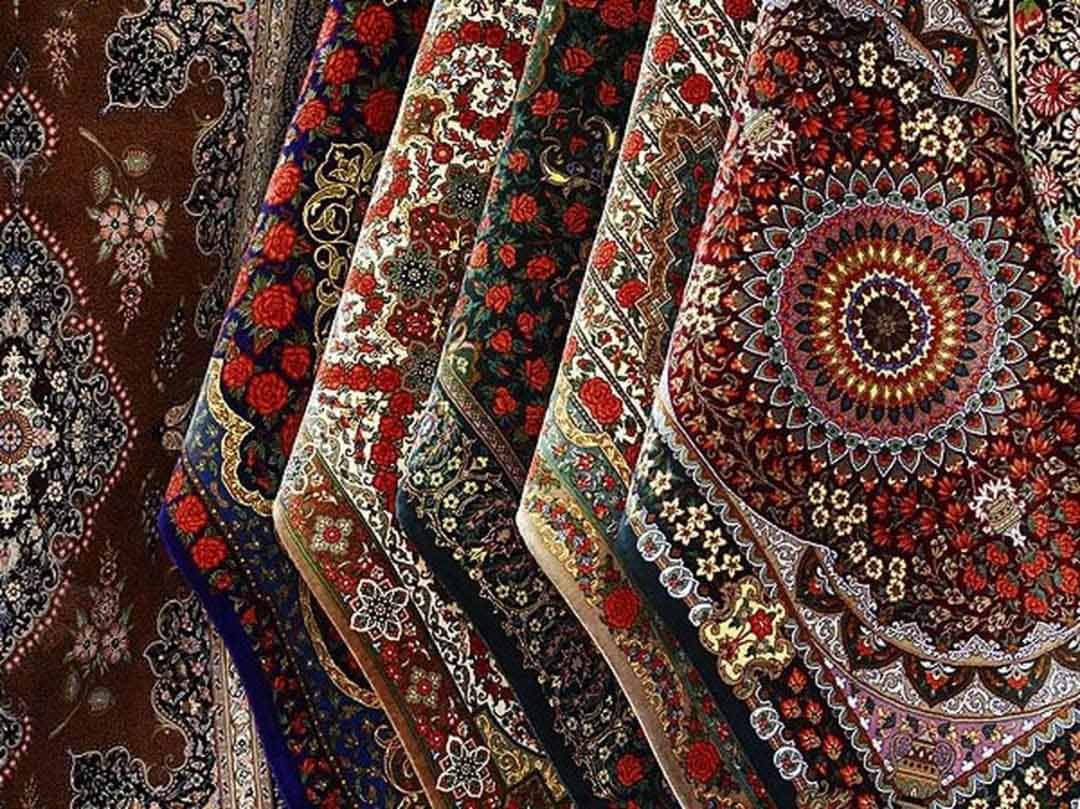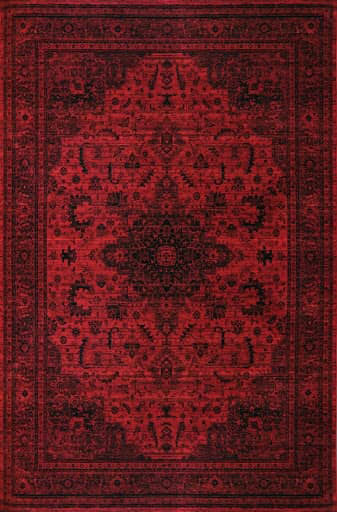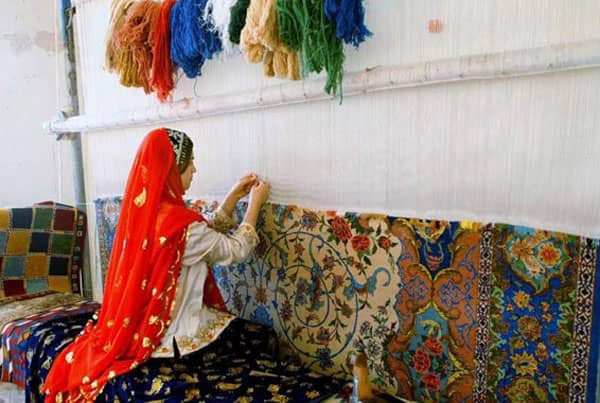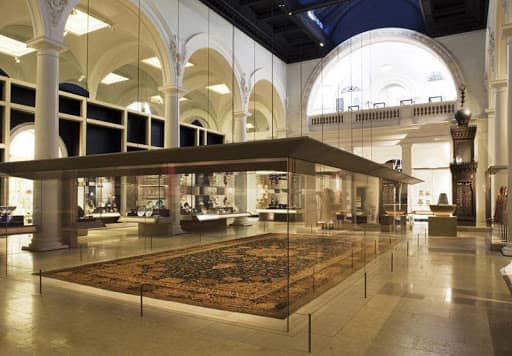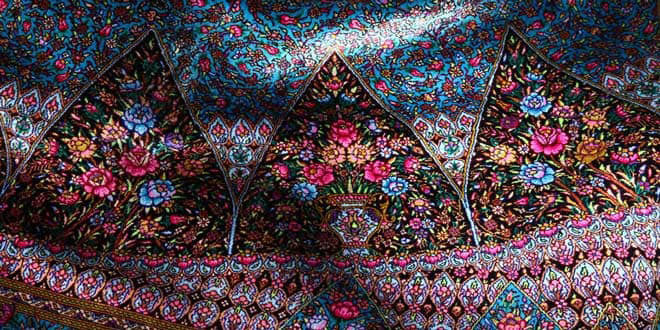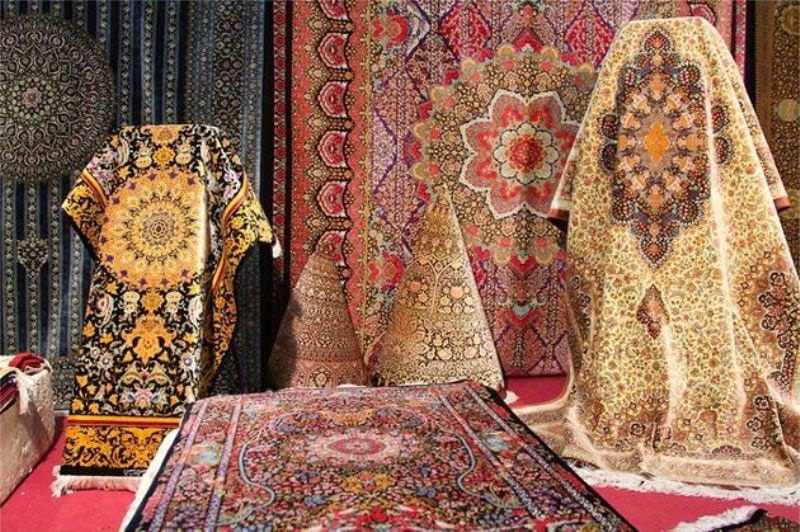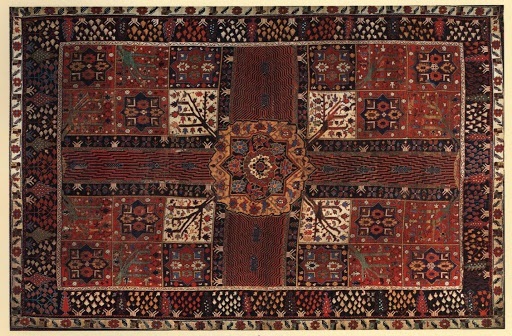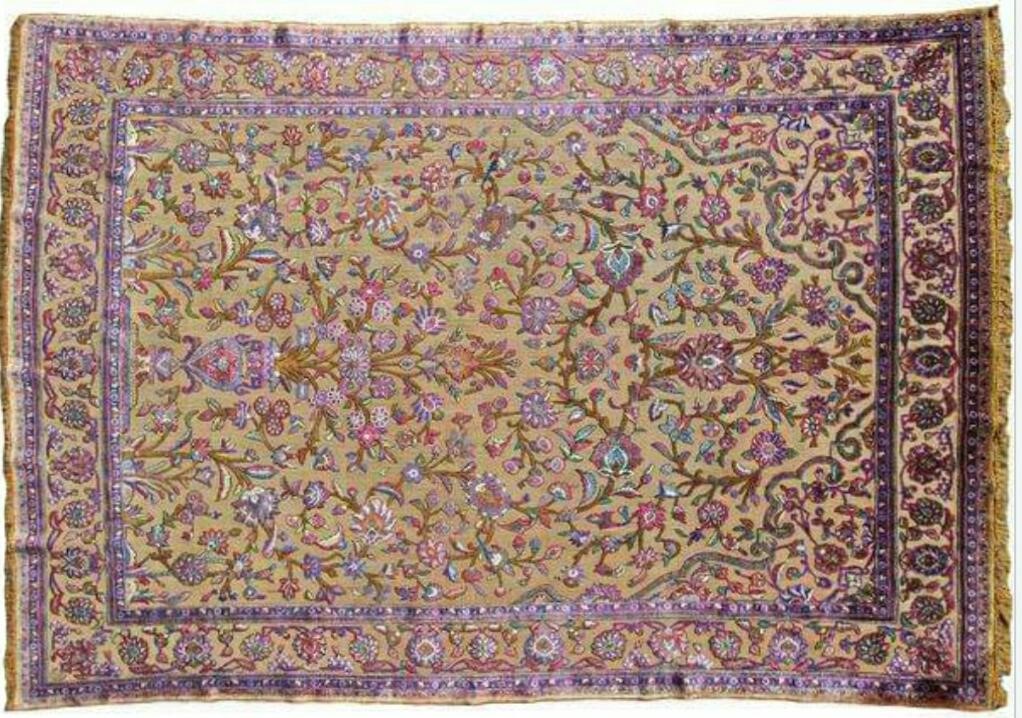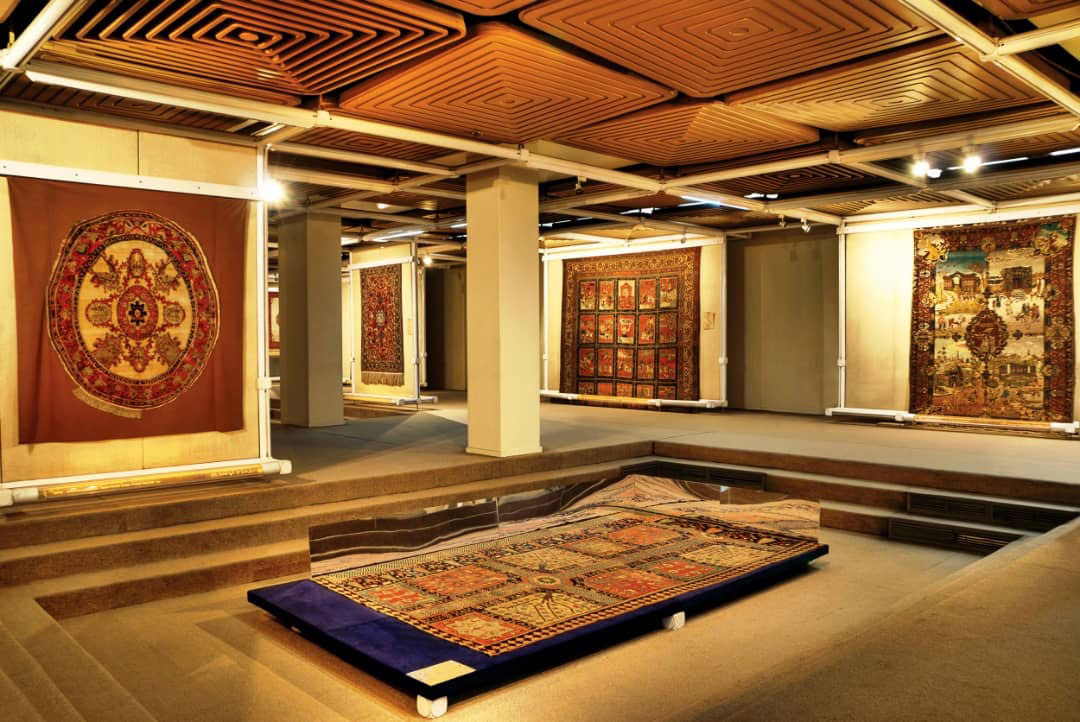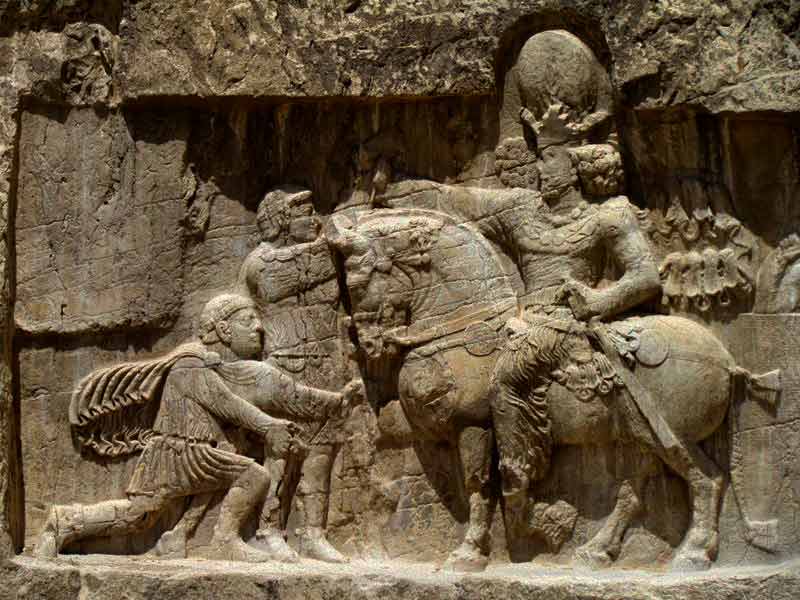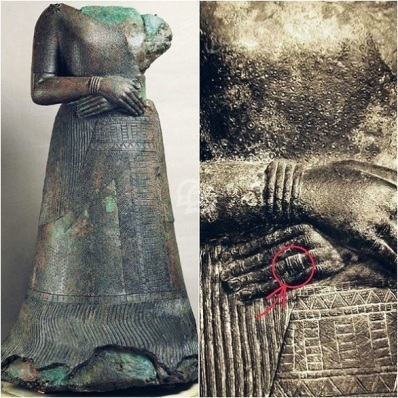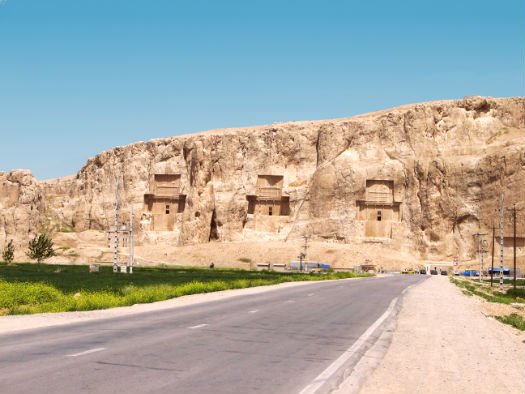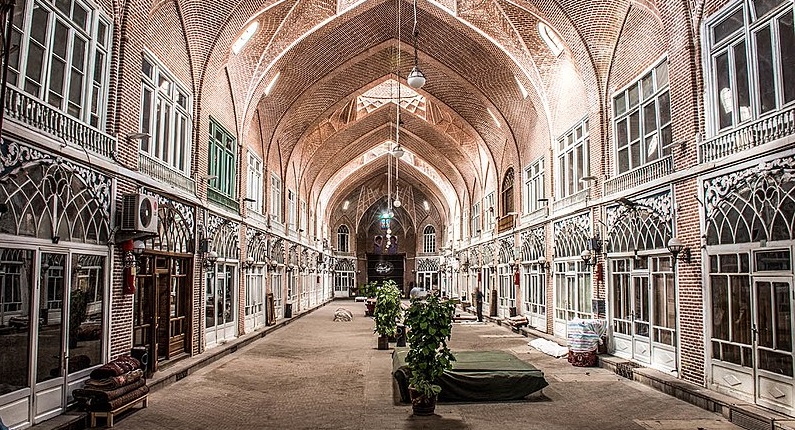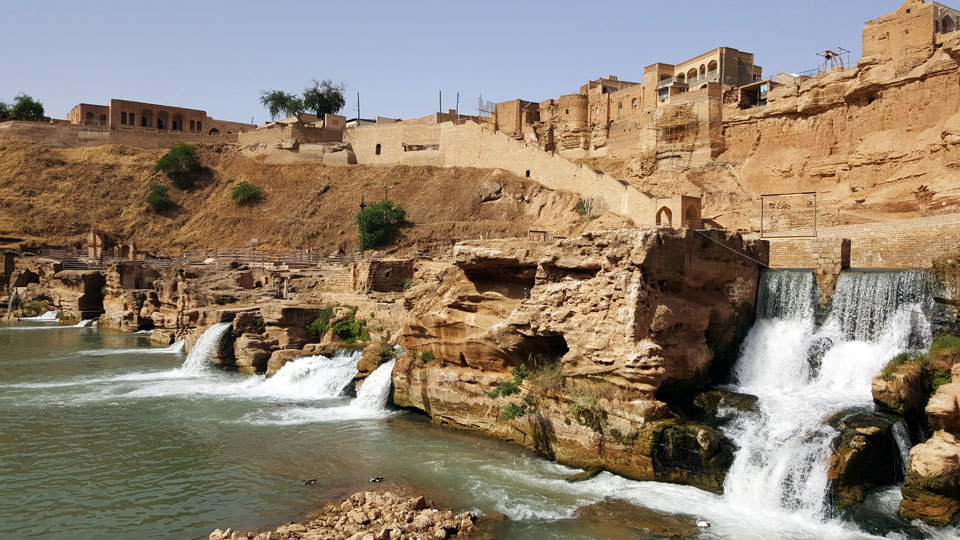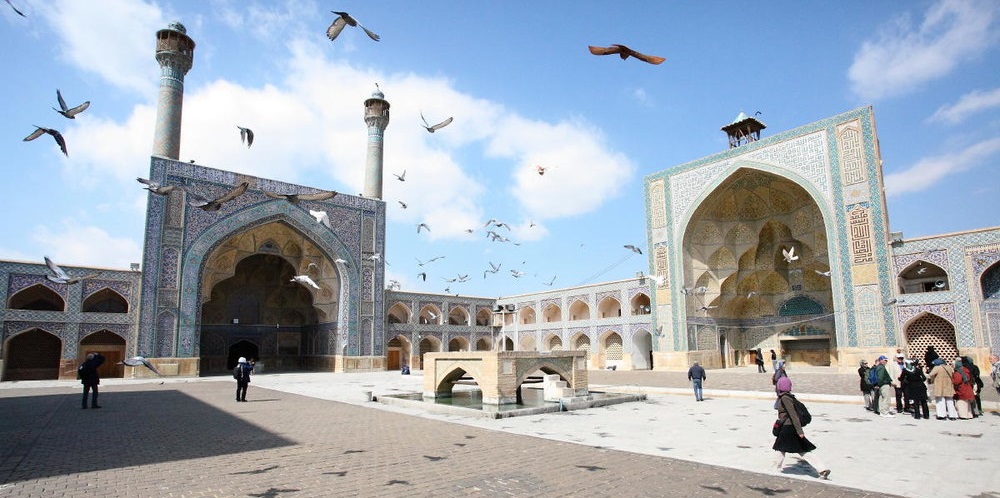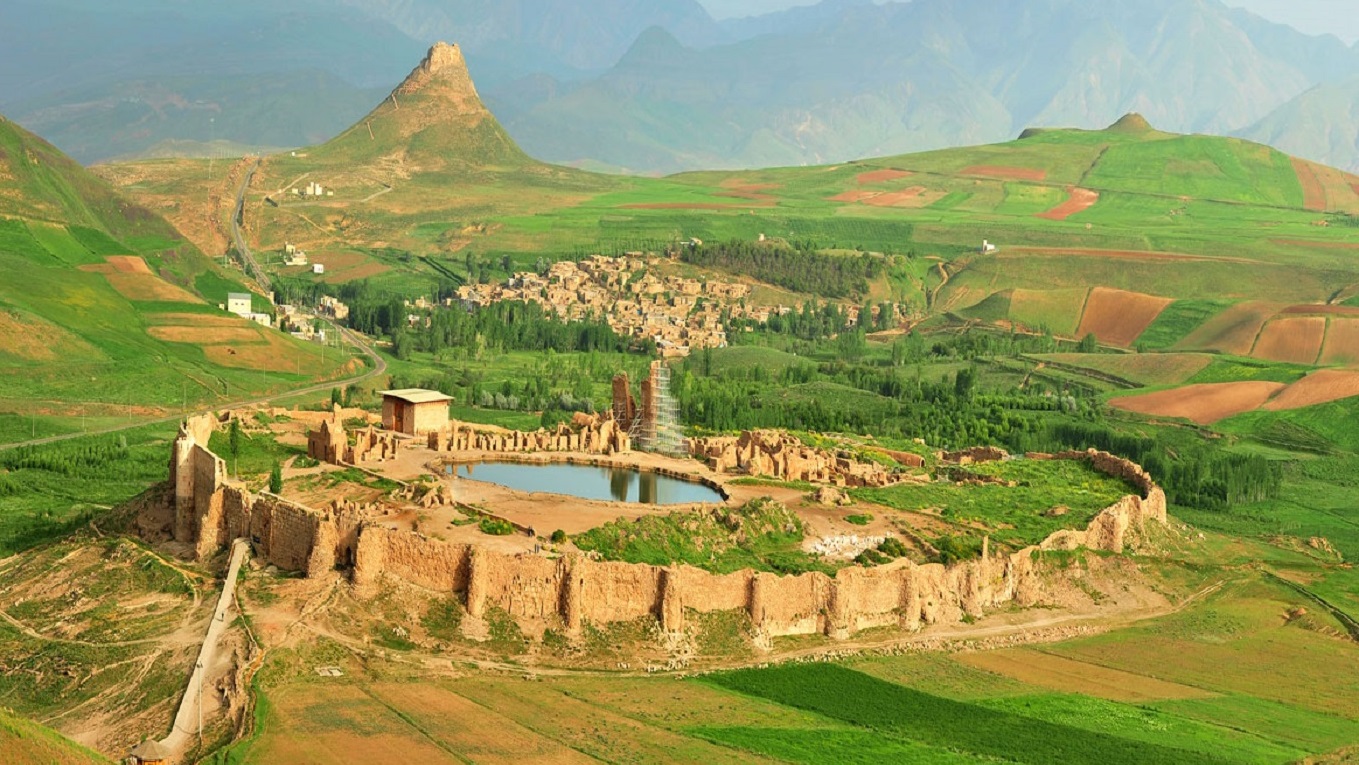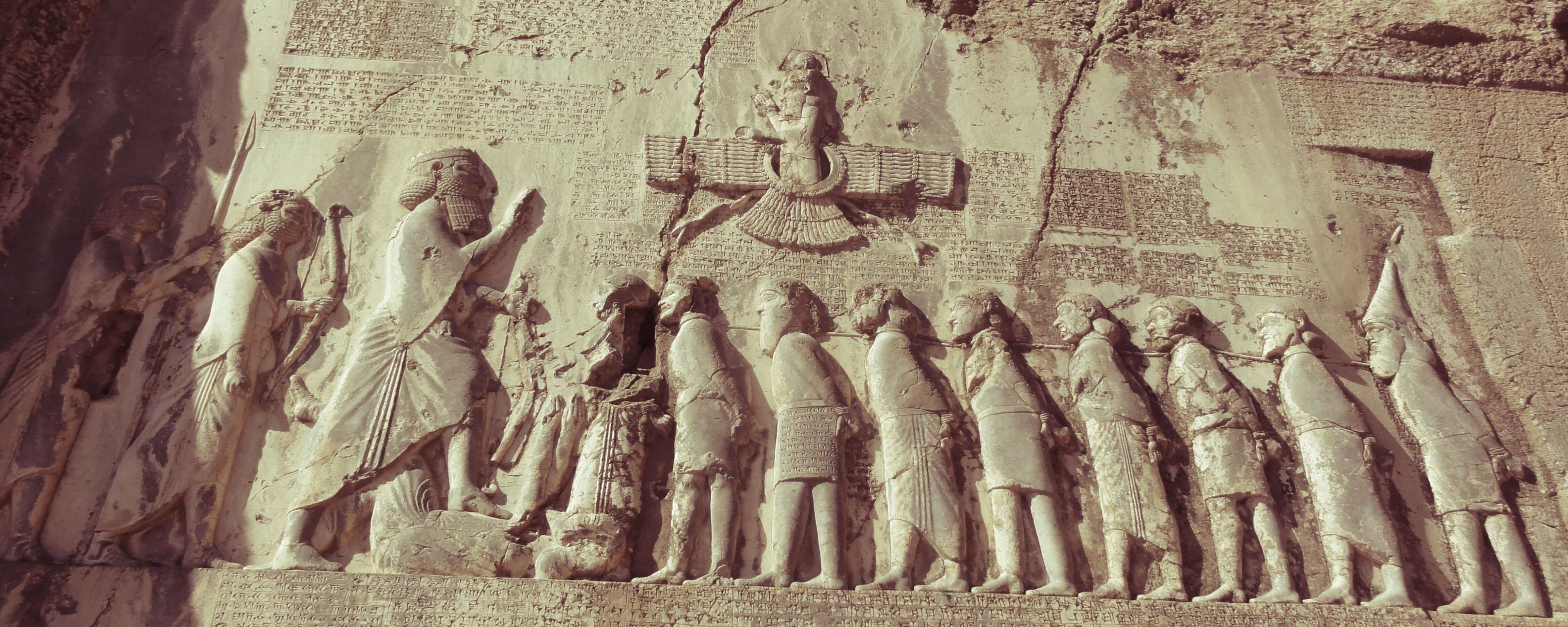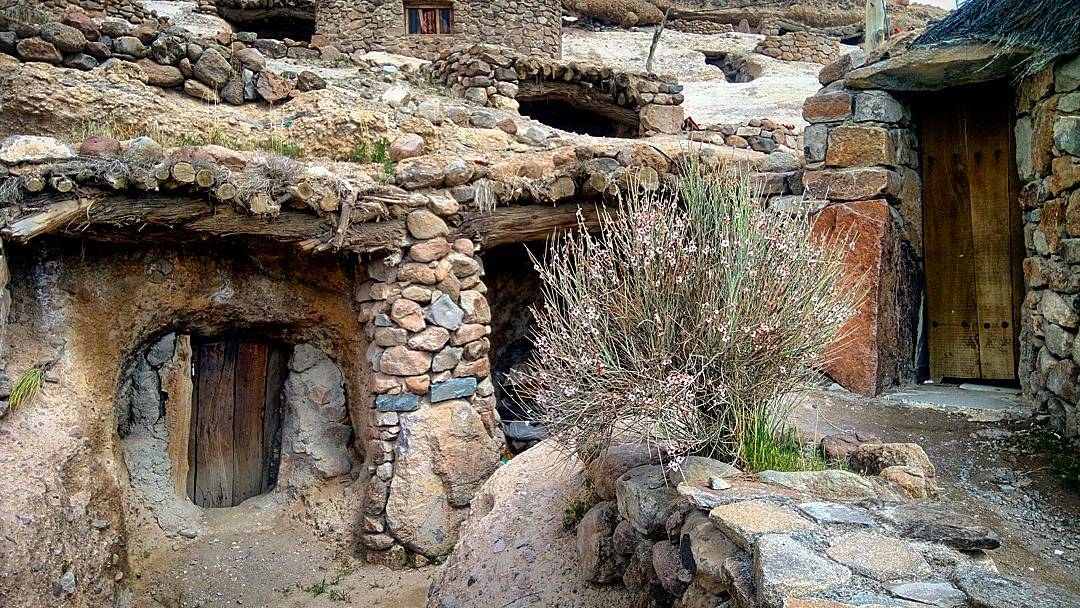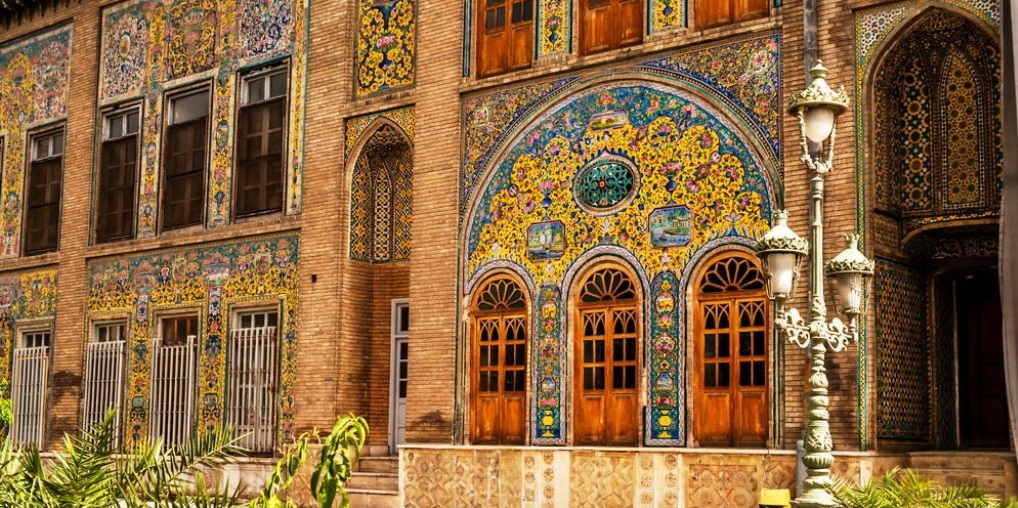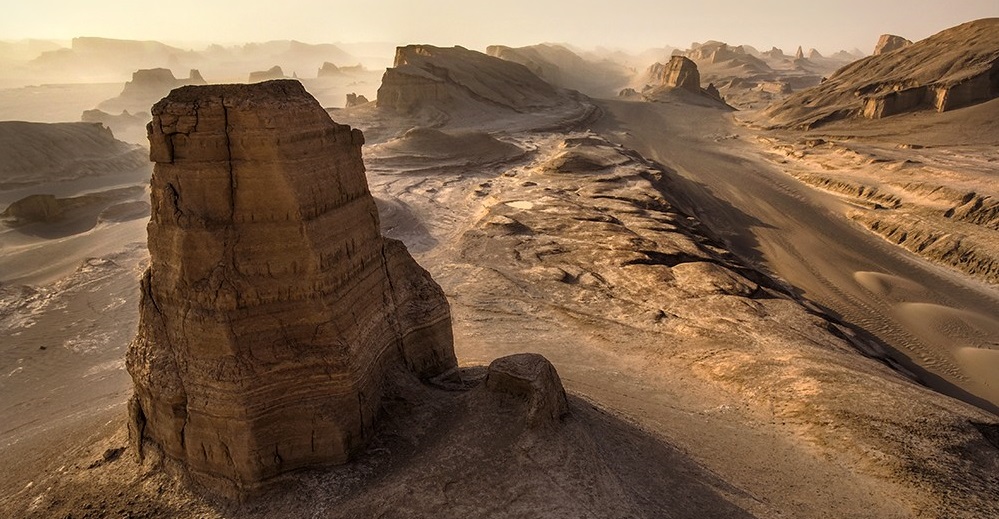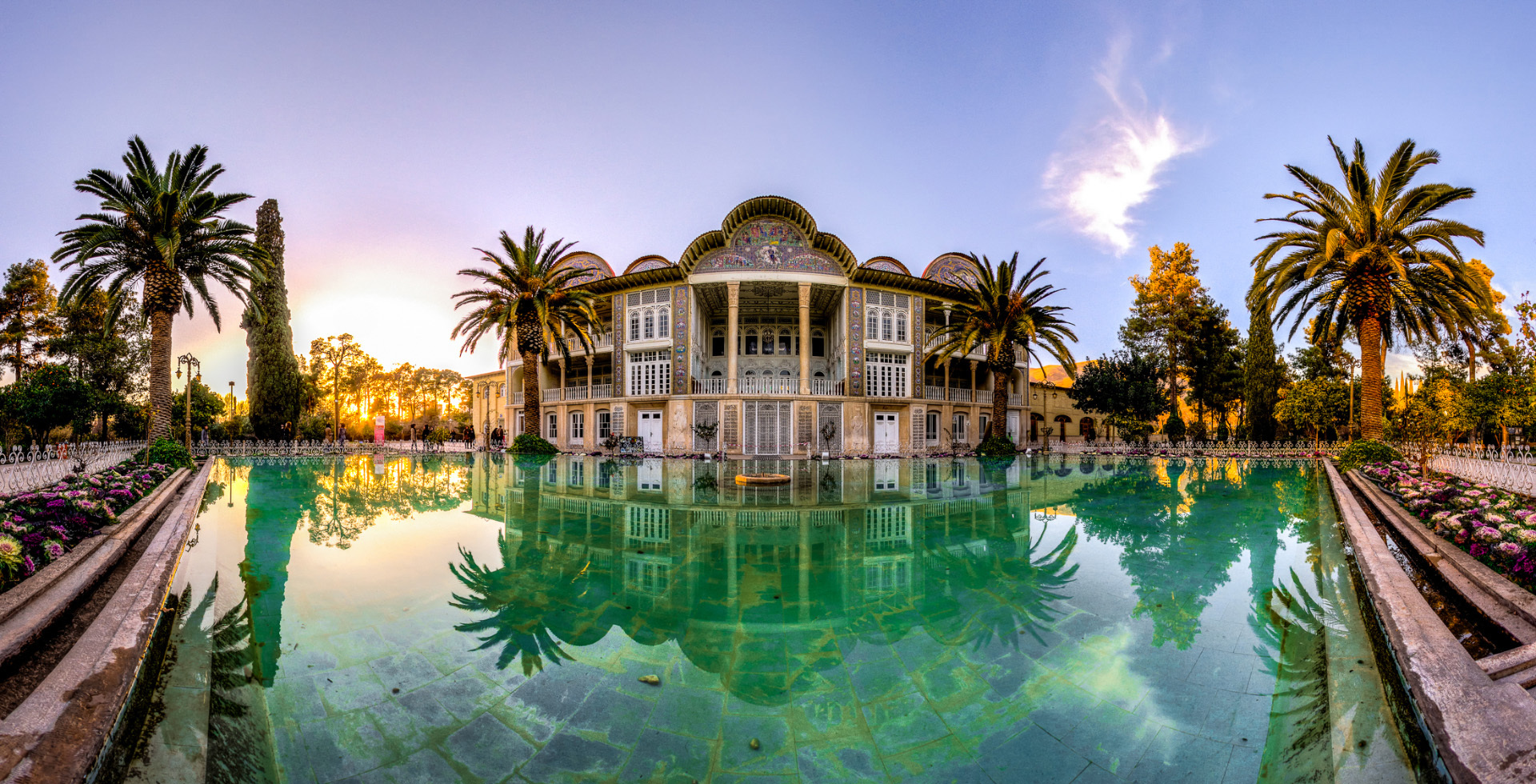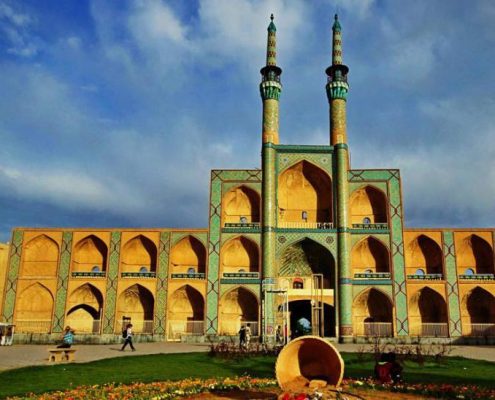History of Persia (Beginning – Revolution)
C. 8000-7500 BC – Pre-Pottery Neolithic period c. 8000 BC – First settlements on the Iranian plateau; the earliest domestication of sheep and goats in Iran c. 7500-5000 BC – Pottery
Neolithic period c. 6300 BC – First evidence of copper smelting in Iran c. 5000-3500 BC – Chalcolithic period c. 5000 BC – A wine jar discovered at the Hajji Firuz Mound proves to be the world’s oldest evidence of wine-making c. 4000 BC – Sialk Mounds
(pi 65) yield some of the most ancient remains of settled life on the Iranian plateau c. 3500-2000 BC – Early Bronze Age
By the end of the 4th millennium BC, craftsmen had made a great progress in pottery; producing the most vivid and lively painted ceramics, found at the Sialk Mounds and Susa. This pottery is decorated with geometric abstractions, showing a naive but strong expression of the lives of its makers.
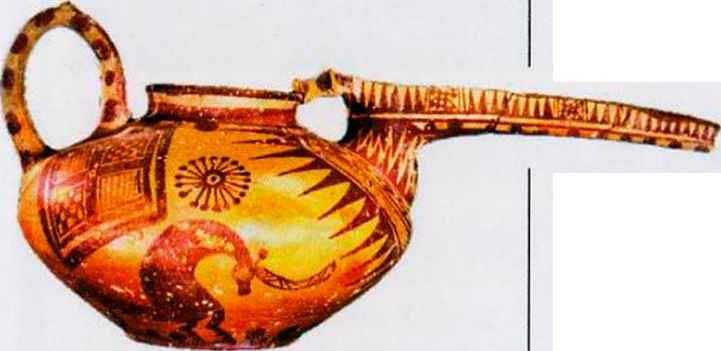
sialk-kashan-earthenware
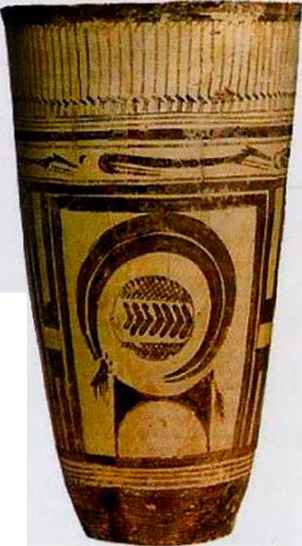
sialk-kashan-painting
Early Civilizations in Iran
Man’s presence on the Iranian plateau during the Paleolithic and Mesolithic ages has not yet been properly studied. Life during the Neolithic period, however, is much better known. Considerable geological and natural evidence has proven that Iran was home to one of mankind’s first major cultures, ahead of every other part of the world except Egypt, Mesopotamia, and India. Significant shifts in tool manufacture, settlement patterns, and subsistence methods, including domestication of plants and animals, characterize the Neolithic Iranian settlements, all of which date wholly or in part from the 8th and 7th millennia. Iranians were probably the first to cultivate wheat and dates, and to tame camels and sheep. The existence of rich mines in Iran can be an indication that metal was excavated and processed here since ancient times. One of the recently excavated archaeological sites – Arisman (p201) – has proved to be one of the world’s earliest centers of the metallurgical industry. By approximately the 6th millennium BC, village farming was widespread over much of the Iranian plateau and in lowland Khuzestan. Among others, Sialk [pi65) on the rim of the central salt desert has yielded evidence of fairly sophisticated patterns of agricultural life. Having begun in the Paleolithic era, Iran’s first vigorous growth had developed by the 3rd millennium BC into a civilization of great sophistication – Elam.
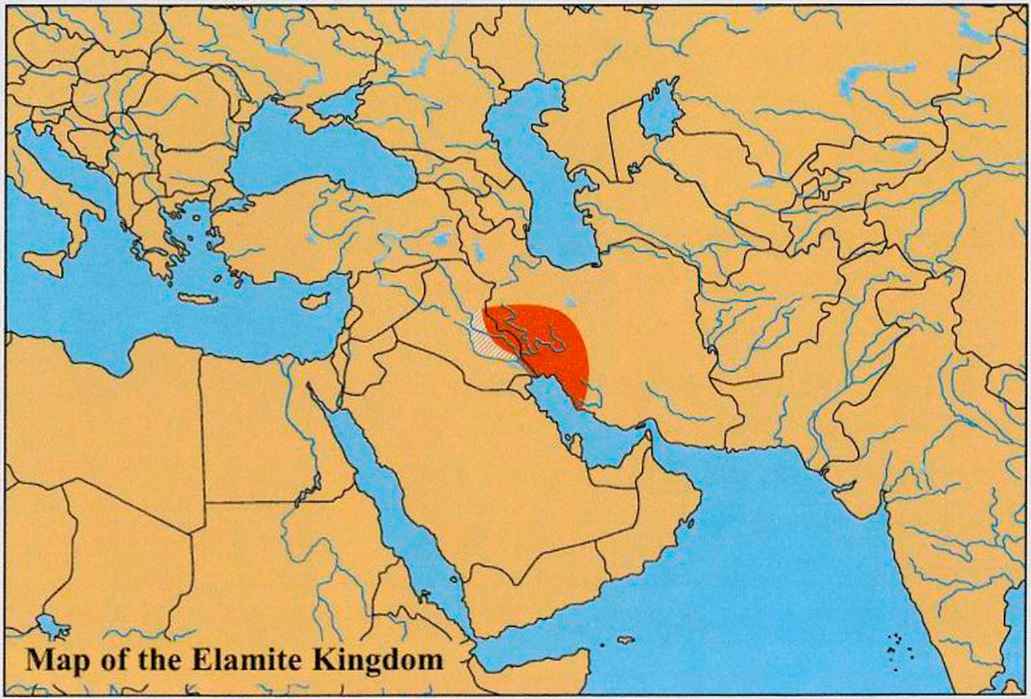
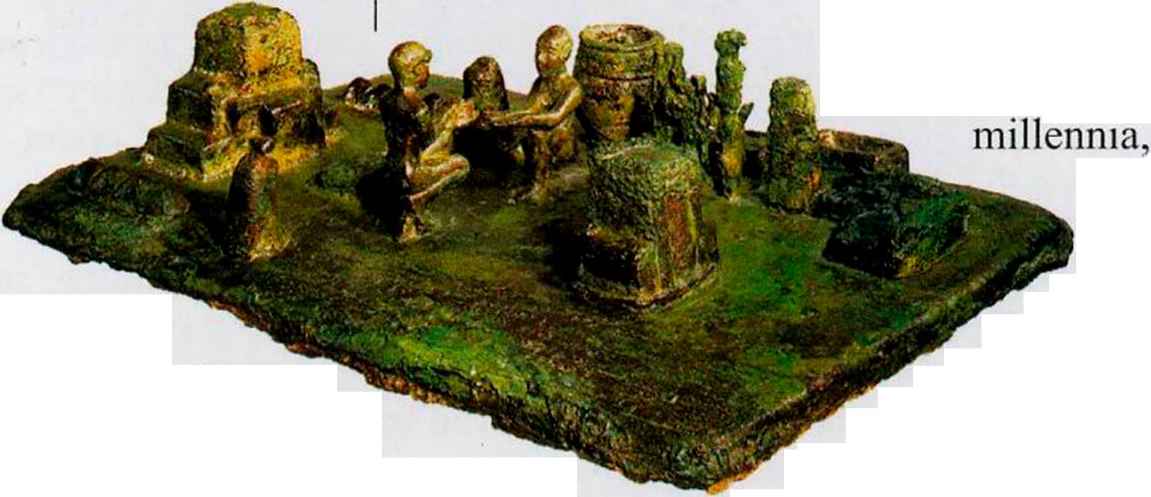
1000-bce-judaism
C. 2700-1500 BC -Old Elamite period 2348 BC -Year of the Flood, 600 years after the birth of Noah, as will be reckoned by Biblical chronology c. 1700 BC-Judaism is founded by Abraham c. 1500-1000 BC-Middle Elamite period c. 1450-1250 BC – Iron Age I c. 1340-1300 BC – A new capital and religious complex, including a ziggurat, is built by King Untash-Gal at Chogha-Zanbil c. 1250-800 BC – Iron Age II c. 1100 BC – Nebuchadrezzar I of Babylon invades Elam, plundering the countryside and destroying Susa; Zoroaster founds a faith whose sacred literature will be the Zend-Avesta; The Iron Age that began more than 400 years before in the Near East moves to Europe 1000-539 BC – Neo-Elamite period 9th century BC – First mention of the Iranians in Assyrian texts 961-931 BC – Rule of Judea’s King, Prophet Solomon c 800 BC – Hasanlu, a Mandaean fortified city in northwestern Iran is destroyed
800-550 BC – Iron Age III
Elam BC
In the late 4th and early 3rd a brilliant ancient culture came into being on the Iranian territory – Elam, “The Land of Gods”. The origin of the Elamites is unclear. Their earliest kings reigned around 2700 BC. These early rulers were succeeded by the Awan (Shustar) dynasty, which was then replaced by a new ruling house, the Simash dynasty. About the middle of the 19th century BC, power in Elam passed to a new dynasty, that of Eparti.
This Elamite bronze tableau is the only three-dimensional example of worship in progress in the ancient Middle East (now in the Louvre)
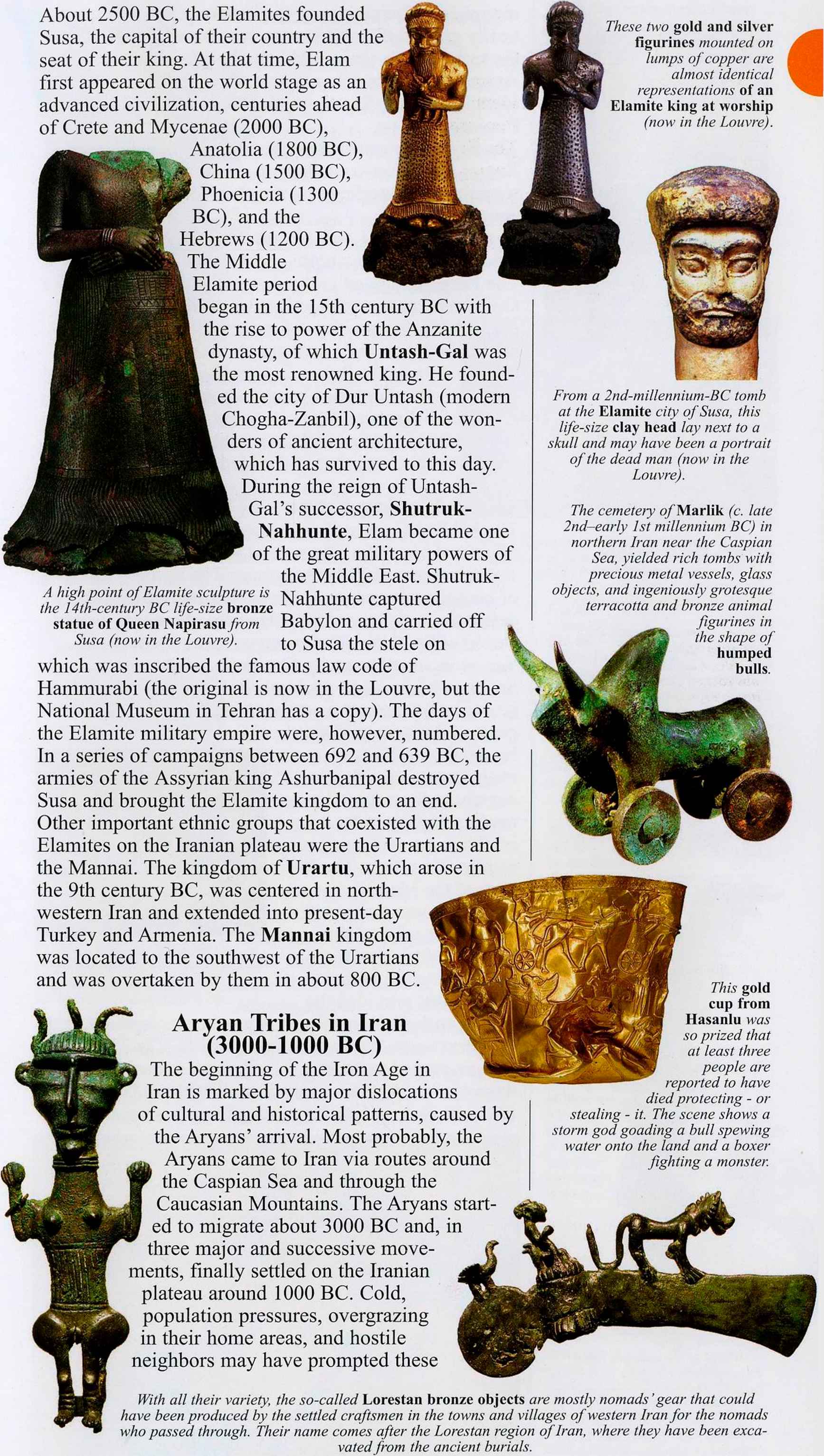
elamites-glass-iran
These two gold and silver figurines mounted on lumps of copper are almost identical representations of an Elamite king at worship (now in the Louvre).
From a 2nd-millennium-BC tomb at the Elamite city of Susa, this life-size clay head lay next to a skull and may have been a portrait of the dead man (now in the Louvre).
The cemetery of Marlik (c. late 2nd—early 1st millennium BC) in northern Iran near the Caspian Sea, yielded rich tombs with precious metal vessels, glass objects, and ingeniously grotesque terracotta and bronze animal __ figurines in the shape of m. humped 4 bulls.
Died protecting – or stealing – it. The scene shows a storm god goading a bull spewing water onto the land and a boxer fighting a monster.
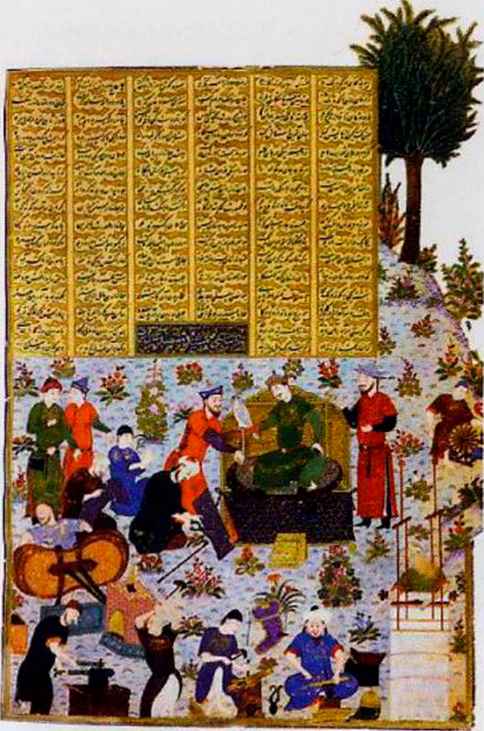
iranian-king-jamshid
According to Iranian myths, King Jamshid led his people from lran-Vij (a mythical place, probably the last common motherland oflndo-lranians) to Iran. He is reported to have shoved his sword into the earth three times, and made it expand thrice as big during three periods – the myth that has prompted the scholars that Aryan migrations were held in three major waves.
According to Iranian myths, King Jamshid led his people from lran-Vij (a mythical place, probably the last common motherland of lndo-lranians) to Iran. He is reported to have shoved his sword into the earth three times, and made it expand thrice as big during three periods – the myth that has prompted the scholars that Aryan migrations were held in three major waves.
825 BC – Rise of the Medes
776 BC – Greece’s first recorded Olympic games are held 753 BC – The city of Rome is founded 728 BC – Deioces founds the Median Empire 644 BC – Assyrian king Ashurbanipal sacks Susa, ending Elamite supremacy 633-584 BC – Cyaxares 612-606 BC-Medes and Babylonians overthrow Assyrian Empire; destruction of Nineveh 584-550 BC – Astyages 565 BC – Daoism is founded by the Chinese philosopher Lao Zi 550 BC – Astyages is defeated by his grandson, future Achaemenid king Cyrus II
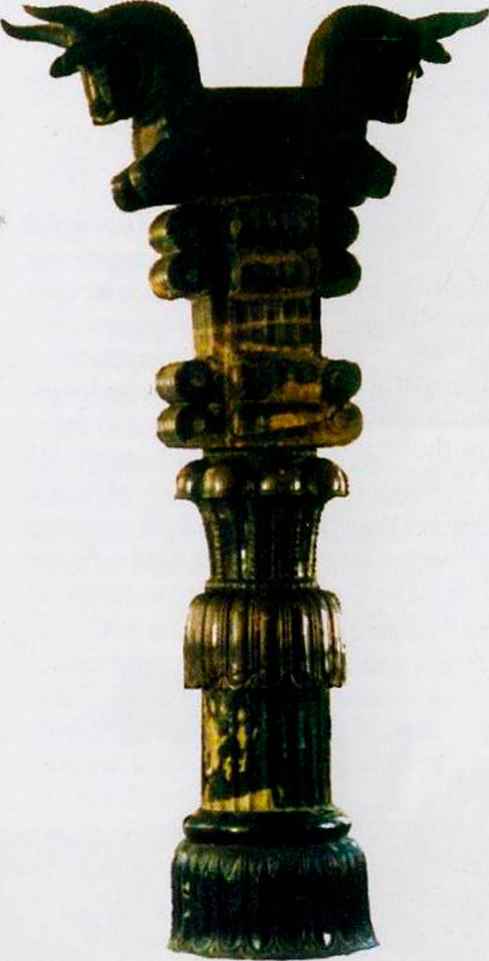
persepolis-palace-darius
Parts of the column from Persepolis, a complex of palaces built by Darius the Great and his successors, almost exclusively to stage the ceremonies of the Persian New Year (today in the National Museum in Tehran).
Migrations. The natives of the Iranian plateau enthusiastically greeted the newcomers, who brought with them the technologies that could help them to survive. Among the Aryan tribes in Iran, three major groups are identifiable – the Scythians, the Medes, and the Persians.
The Scythians established themselves in the northern Zagros Mountains and clung to a semi nomadic existence in which raiding was the chief form of economic enterprise.
The Medes settled over a huge area, reaching as far as modern Tabriz in the north and Isfahan in the south. The Persians settled in three areas: to the south of Lake Orumiyeh, on the northern border of the Elamite kingdom, and in the environs of modern Shiraz, where they established their main settlements, to which they gave the name Parsa (or Persia, in Greek). Gradually Iranian tribes, especially under the pressure of constant Assyrian attacks, started to reorganize themselves into kingdoms and then empires. The first-known Iranian empire was that of the Medes.
Median Empire BC
The Median Empire started with Deioces’s rule. He organized his realm into several provinces and created a strong army to stop the Assyrians. The military genius of his son and successor, Phraortes, helped the Medes defeat the Assyrians. After Phraortes, there was a short period of Scythian domination over the Medes until they were overthrown by Cyaxares, who induced Scythian kings to get so drunk that they were then easily slain. Cyaxares, the greatest king of the Medes, reorganized the army and utterly defeated the Assyrians. At his death, the Medes controlled vast territories, stretching from Anatolia in modern Turkey to the area of Tehran as well as all of southwestern Iran. The last king of the Medes, Astyages, was perhaps the first unjust ruler of the country. Moreover, the sim- A sold Mede rhyton is one of the rarest artifacts of the Mede period plastic lire style or tne (today in the Reza Abbasi Museum Aryans that provided in Tehran).
Medes with their amazing conquests, was replaced with an extravagant Mesopotamian court life. The Median Empire started to decline. The Persian Achaemenid dynasty, tracing their origin from Achaemenes, in Greek, were gaining power.

median-empire-map
Map of the Median Empire
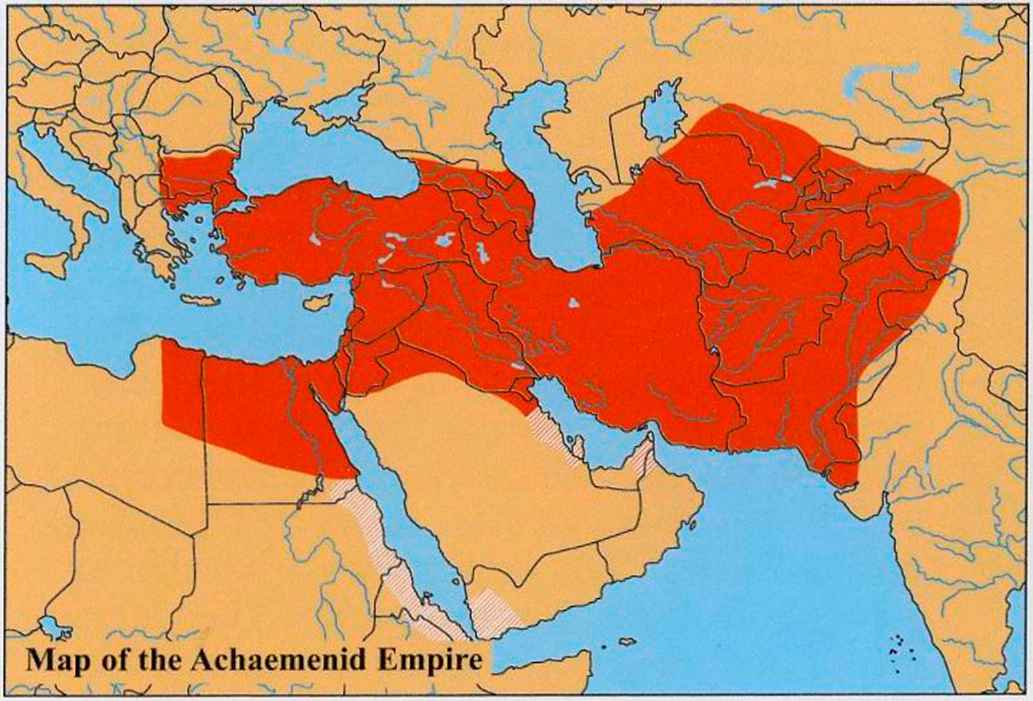
median-empire
Achaemenid Empire B
Cyrus the Great was the first important Achaemenid ruler. By the time he became king, Persia was already a large domain, but Cyrus aspired to nothing less than the conquest of the entire known world. In a campaign that lasted for less than two years, he took Elam, Media, Lydia, and several Greek cities on the Ionian coast. Having strengthened his power, Cyrus besieged and captured Babylon and released the Jews who had been held captive there, thus earning immortality in the Book of Isaiah. His territories in the east also were great and stretched as far as the Hindu Kush in present-day Afghanistan. Cyrus was a world conqueror unlike any other. Not only Persians but even Greeks held him in the sentiments of esteem and even awe, and it was no accident that Xenophon praised Cyrus as an ideal monarch. Cyrus died in battle, while putting down a revolt, and was buried in Pasargadae, the capital he had founded. Cyrus’s son and successor, Cambyses II, was less successful. However, he managed to invade Egypt and create the dynasty of Persian kings there. He was killed (or died of a self-inflicted wound) during a revolt led by a priest, Gaumata, who held the throne until overthrown by a member of a collateral branch of the Achaemenid family, Darius I. Darius I, another “Great” of the Achaemenid dynasty, finished Cyrus’s incomplete job of invasion, having conquered Northern India and some parts of Greece, as well as the whole of Asia Minor.
Important Achaemenid Kings:
Cyrus II, The Great – 559-530 BC Cambysus II – 530-522 BC Darius I, The Great – 522-486 BC Xerxes I – 486-465 BC Artaxerxes I – 465-425 BC Darius III – 336-330 BC
c. 559 BC – Croesus, king of Lydia, invents metal coinage 550 BC – Persian Empire, the first major Indo-European power, is established by Cyrus the Great 549 BC – Armenia becomes a Persian satrapy after 63 years under the kings of Media 546 BC – Cyrus defeats Croesus 539 BC – Cyrus conquers Babylon and Syria
Cyrus’s Mausoleum in Pasargadae is an early example of Achaemenid monumental art (photo by Naser).
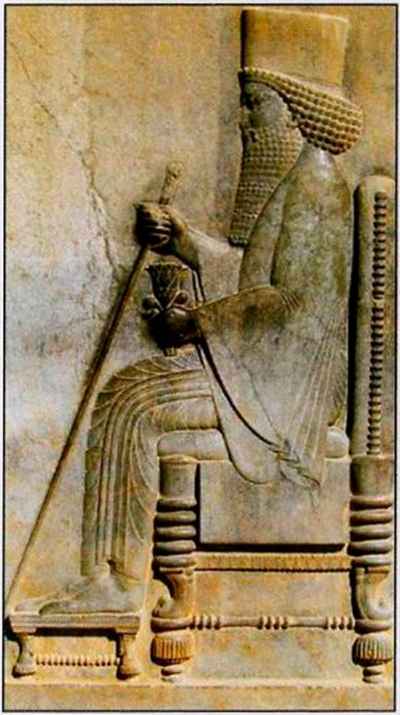
median-empire
528 BC – Buddhism has its beginnings in India
525 BC – Cambysus conquers Egypt; he learns that his throne has been usurped by a “false Smerdis” (called by Darius Gaumata, a Magian priest from Media) and dies en route home from Egypt 521 BC – “False Smerdis” is killed in battle by Darius I 500 BC – Beginning of Persepolis’s construction 495 BC – Confucian teaching is spread in China
490-479 BC – Persian-Greek wars 490 BC – Battle of Marathon, won by the Greeks
481 BC- Persian victory over the Spartans at Thermopylae; Xerxes conquers Athens and sets lire to the Parthenon
480-479 BC – Battles of Salamis and Plataea, won by the Greeks
449 BC – Herodotus writes his Histoiy
333 BC – The Battle of Issus is won by Alexander the Great over the Persians
331 BC – The Battle of Arbela (Gaugamela) in northern Mesopotamia gives Alexander the Great another victory over Darius III 330 BC -Darius III is murdered by his satrap Bessus
The so-called Oxus Treasure comprises about 170 items, mostly dating from the 5th and 4th centuries BC. The gold ringlet with griffins is one of the most spectacular pieces of this collection. Ringlets were considered a prestige gift at the Persian court.

gold-susa-louvre
In a watercolor painted in 1913 by French architect and archaeologist Maurice Pillet, Darius I leads a procession into his palace at Susa. Susa was always the pride of the Elamites and later the Persians, a city that stood for 5000 years until totally sacked and razed by the Mongols.
A golden bowl from the Achaemenid period features a cuneiform inscription in Old Persian, saying
“Khashayarsha [Xerxes], the King yy
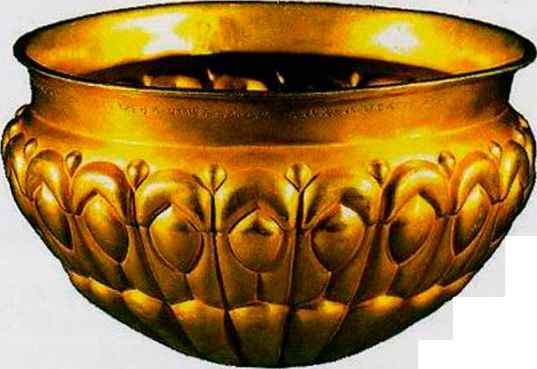
achaemenid-empire-symbol
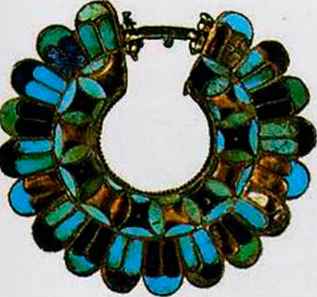
Earrings inlaid with turquoise and lapis lazuli and similar in design to this pair from Susa were common during the Achaemenid period; they were worn by both men and women (now in the Louvre).
330 BC – Alexander becomes master of the Persian Empire and destroys Persepolis 323 BC – Alexander dies at age 32, and a 42-year struggle begins that will be called the Wars of the Diadochi (successors) 317 BC – Armenia’s Persian satrap Ardvates frees his country from Seleucid control
310 BC – Cassander, Macedonian ruler, has Roxana, widow of the late Alexander the Great, put to death along with her young son, Alexander IV
245 BC – Babylon and Susa fall to the Egyptian armies of Ptolemy III
Important Seleucid Kings:
Seleucus I Nicator – 312-281 BC
Antiochus I Soter – 281-261 BC
Antiochus II Theos – 261-
The statuete of Zeus
(Today in the National Museum in Tehran) exhibits direct Greek influence in Persian art.
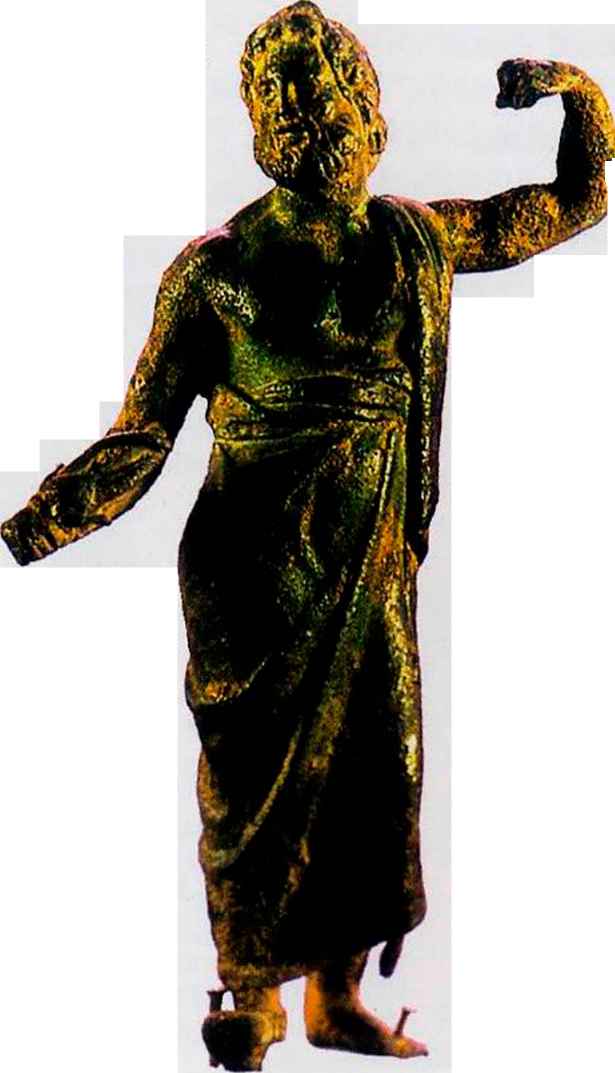
seleucid-empire-art
Tured to the northern Black Sea region, but was thrown back by the Scythians. Darius also attacked the Greek mainland, but as a result of his defeat at the Battle of Marathon was forced to retract the limits of the empire to Asia Minor. Despite this defeat, Darius’s empire was the largest the world had ever known, and administering such a gigantic land was quite a challenge. Maybe not a great army general, Darius was certainly the greatest of politicians. One of his amazing achievements was creating the world’s first highway network. The stone-paved Royal Road, 2,703 km (1,679 miles) long, ran from the empire’s winter capital at Susa to Ionian Ephesus on the Mediterranean and had 111 stations. Darius is also credited for the introduction of the world’s first postal system (band). He coined money (darik), established the institution of political marriage, appointed royal inspectors to be aware of state affairs, and was the first ruler to ask for sons and heirs of the defeated kings as hostages and guarantors of their fathers’ loyalty. Other accomplishments of Darius’s reign included the codification of data, a universal legal system upon which much of later Iranian law was based, and the construction of a new capital at Persepolis. Trade was extensive and, as a result of this commercial activity, Persian words for typical items of trade became prevalent throughout the Middle East and eventually entered Western languages. Examples in English are bazaar, shawl, tiara, orange, lemon, peach, ‘chalcedony’Though rarely repre-spinach, and asparagus.
His successor Xerxes, the Achaemenid power started to decline. The last Achaemenid king, Darius III, was overthrown by Alexander the H Great. In 330 BC, the 26-year-old Macedonian conqueror set fire to Persepolis and put a full stop to the Achaemenid rule.
Hellenistic Period 323-141 BC
In his world-conquering campaign, Alexander hoped for a fruitful union of the Europeans with the peoples of the Middle East. In the effort to reach this goal, Alexander married Roxana, daughter of the most powerful of the Bactrian chiefs, and commanded 80 of his top officers and 10,000 of his soldiers to marry Persian women in a mass wedding at Susa. However, his plans to consummate the union of the Greek and Iranian peoples ended when Alexander was struck with fever and died in Babylon. His generals began squabbling over rights to his extensive empire. They assassinated Alexander’s widow and son, and all but…
Then they divided the empire among three of them. Iran passed on to Seleucus, the only officer under Alexander who had kept his Iranian wife whom he genuinely loved. He eventually became known as Seleucus I Nicator, or the “Conqueror”. Under Seleucus’s son, Antiochus I, many Greek colonists entered Iran. By establishing mixed Greek-Iranian colonies, the Seleucids tried to strengthen their power. A strong Seleucid monarch, Antiochus III, the sixth in the Seleucid line of kings, was successful in suppressing the threat of constant insurrection by local rulers, but in general he could not stem a tide of rebellion that arose in the Iranian provinces. Despite Selucid’s strenuous efforts to introduce Greek culture in Iran, the Greeks remained strangers to the Iranian people. After approximately a century and a half of Greek rule in Iran, the Seleucids were completely overthrown by the Parthians.
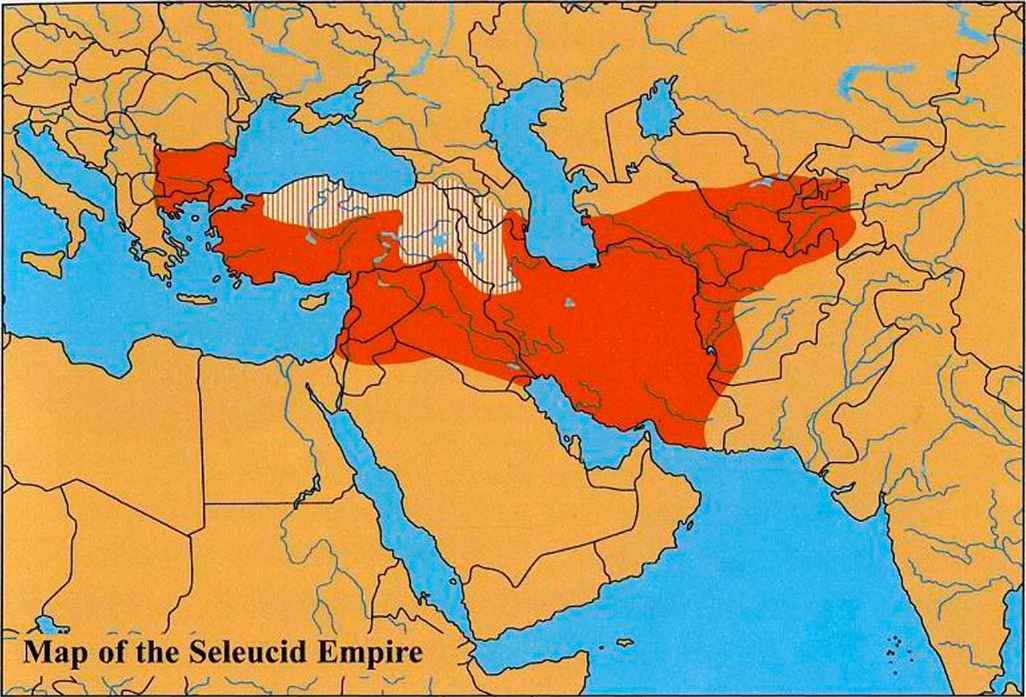
leucos-nicator
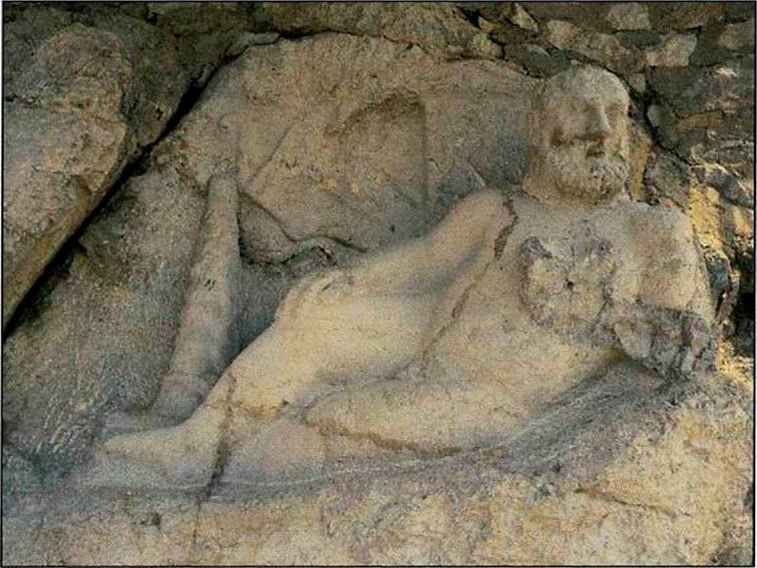
seleucid-statue-hercules
Drinking cup in hand, club resting by his feet, a life-size Hercules lounges on a lion skin beside Bisotun. A protective canopy casts a shadow across a corner of the Seleucid rock carving, which has been dated 148 BC by a Greek inscription found behind it (photo by Naser Mizbani).
Parthian Empire (247 BC-224 AD)
Under the Achaemenids, a satrap named Parthava was annexed to the empire during Cyrus the Great’s campaign south and east of the Caspian Sea. The Parthians were among the first to revolt against the Seleucids and were led by two brothers, Arsaces and Tiridates. Arsaces was proclaimed the first king, and his name became the honorific title used by all subsequent Parthian kings, who were generally known as the Arsacids.
Mithradates I is considered the founder of the Parthian empire. He is believed to have established his capital.
Important Parthian Kings:
Arsaces I – 250-247 BC Tiridates-247-211 BC Artabanus 1-211-191 BC Mithradates I – 161-138 BC Phrates II- 138-124 BC Mithradates II, the Great – 123-87 BC
Orodes II – 54-38 BC Phrates IV – 38-29 BC Artabanus V – 216-224 AD
250 BC – Parthians (Arsacids) capture Khorasan from the Seleucids
2nd century BC – The Silk Road “opens” for commercial trade of silk and other goods 129 BC – Phrates II finally defeats the Seleucids
92 BC – Mithradates II makes an alliance with Rome and invades Mesopotamia; Mithradates II concludes the first peace treaty in the history of Parthia and Rome 53 BC – The Roman legions under Crassus suffer a decisive defeat at the hands of the Parthians at Haran (ancient Carrhae) in Mesopotamia; this victory elevates the Parthians into a superpower of their era 46 BC – Caesar institutes the Julian calendar
36 BC – The Partians defeat Mark Anthony’s troops in Azerbaijan.
23 BC – The Roman Emperor Hadrian averts a new war with the Parthians by meeting in person with the king of Parthia 222 – Succesful revolt of Ardashir, the ruler of Persia, against Artabanus V
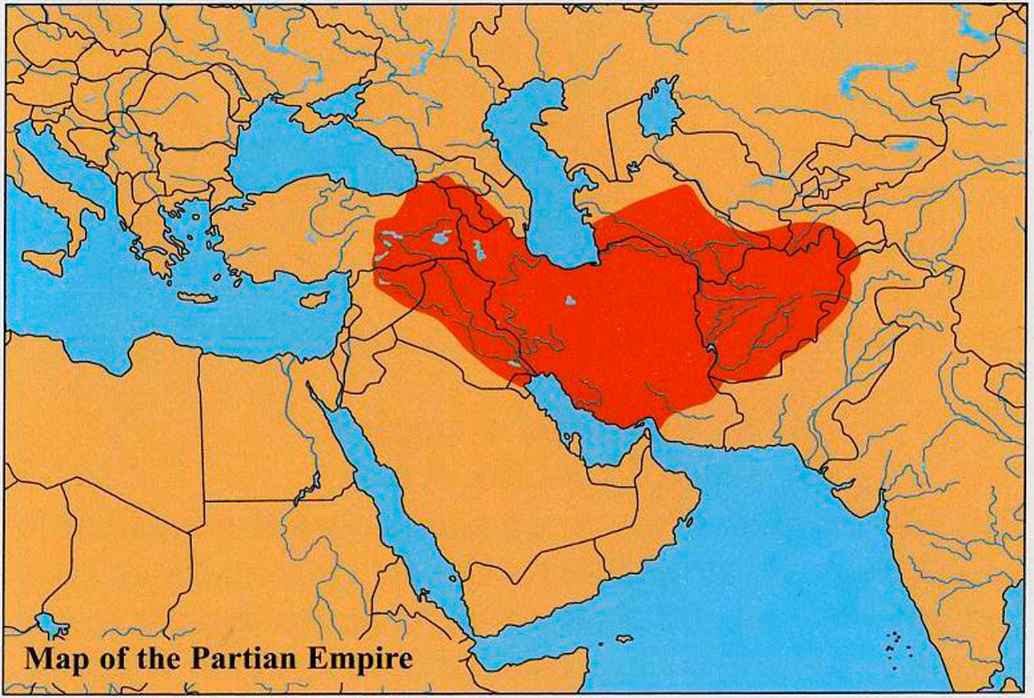
revolt-ardashir
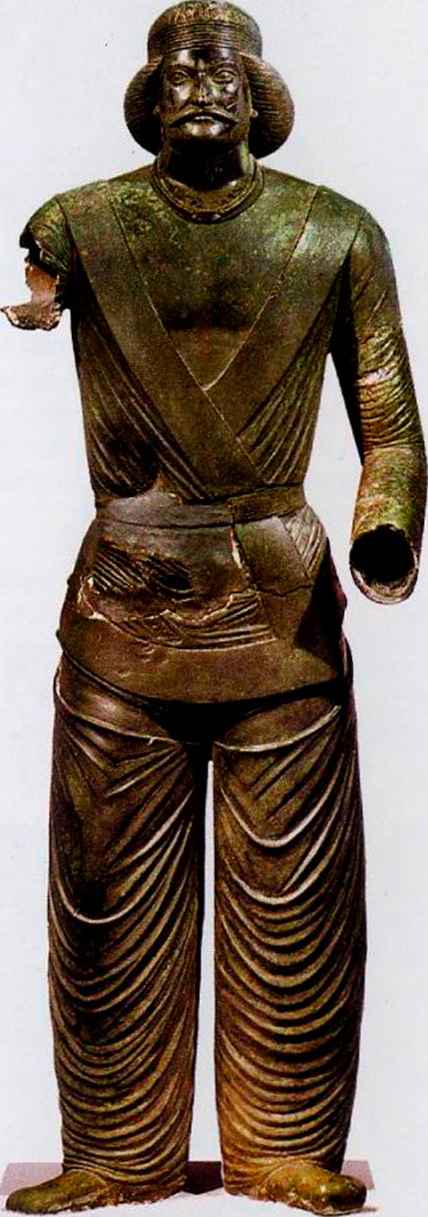
Sorena
Among the most important artistic remains from the Parthian period is a bronze statue of a prince, now kept in the Iranian National Museum in Tehran.
Sassanid Empire (224-651 AD)
The last Parthian king, Artabanus V, lost the final battle to the Sasanids around 224 AD near Hormozdegan (site unknown). A legend claims that Ardashir Babakan, a vassal of Artabanus V, provoked the encounter.
Hunting scenes are the most popular themes on Sasanid silver plates.
Sasanid coins often shown fire altars on their reverse sides, as seen on one of Bahrain V’s coins.
Founded a city called Gur, or the “Glory of Ardashir”, near Firuzabad. Ardashir traced his ancestry to Sasan, a Zoroastrian priest, who gave his name to the last native dynasty in Persia before the Arab conquest. A strong centralized government, a strict principle of dynastic legitimacy, and an official religion, which were quite contrary to the Parthian confederation and freedom of religious practices, characterized the Sasanid domain, which rapidly rose to rank among the world’s largest empires.
Under Ardashir’s successor, Shapur I, the Sasanid Empire extended from the Indian Punjab to the eastern border of Capadocia in Anatolia. The level of prosperity had risen so much that Shapur I was able to wage a war against Rome and even to take the Roman Emperor Valerian prisoner. In contrast to Ardashir, who claimed to be “king of kings of Iran”, Shapur I assumed the title “king of kings of Iran and non-Iran”, a title that was retained by his successors.
The Sasanids chose the Zoroastrian religion as the main means of unifying the diverse peoples of their expanded country. Shapur I, however, did not oppose Manichaeism, a teaching combining the beliefs of Zoroaster, Jesus, and Buddha. However, his successors suppressed other faiths severely, and the high priest, Kartir, was the most infamous instigator of this intolerance.
Shapur’s victory over Valerian was greatly replicated during the early Sasanid reign. The best relief in Naqsh-e Rostam in Fars shows the victory scene with the utmost splendor.
244 – Roman Eemperor Philip the Arabian makes a disgraceful peace with the Persians 260 – Shapur I takes Emperor Valerian prisoner 242-276 – Preaching of Mani
297 – Nerseh (Narses), the Sasanid king, cedes Armenia and Northern Mesopotamia to Rome
301 – The kingdom of Armenia makes Christianity an official state religion, the first nation to do so
306-337 – Constantine the Great 337-361 – Persian-Roman wars 364 – Emperor Jovian signs an onerous treaty with the Persian Shah Shapur II, yielding the kingdom of Armenia and most Roman holdings in Mesopotamia 371 – Persian Empire reaches its height as the Romans and Persians renew their wars 376 – Peace is established with Rome
421 – Eastern Roman Emperor Theodosius II sends his army against Bahram V
422 – Theodosius II concludes peace with Persia after 2 years of war 460 – A famine that will last for several years begins in the Persian Empire
524 – Rome and Persia renew hostilities to begin a war that will last for 7 years
525 – “Easter Tables” are issued by Roman theologian-mathematician Dionysius Exiguus, giving the birthday of Jesus incorrectly as December 25, 753 years after the founding of Rome, the error that will be standardized in all Christian calendars.
528 – Mazdak advocates abolition of private property and the division of wealth – the world’s first “communist/socialist” ideas.
529 – The Academy founded at Athens by Plato in 347 BC is closed by Emperor Justinian, and many of the professors emigrate to Persia and Syria; Khosrow Anushirvan’s famous prime minister, Bozorgmehr, reportedly invents the game of backgammon
532 – Justinian signs a “Perpetual Peace” with Khosrow I to free his armies for operations in the West
539-562 – Persian-Byzantine war
540 – Persian forces take Antioch from the Byzantines
549 – Pctra falls to the Persians, who will hold the eastern outpost of Byzantium for 2 years
570 – Birth of Prophet Mohammad peace be upon him
572-591 – Persian-Byzantine war
589 – Bahram Chubin, a Persian military, deposes Khosrow II, who flees to Constantinople
591 – Byzantine Emperor Maurice restores Khosrow II to his throne and receives territorial concessions for his help
608-622 – New series of Persian-Byzantine wars
614-615 – Khosrow II captures Damascus and Jerusalem, bringing the True Cross to Ctesiphon
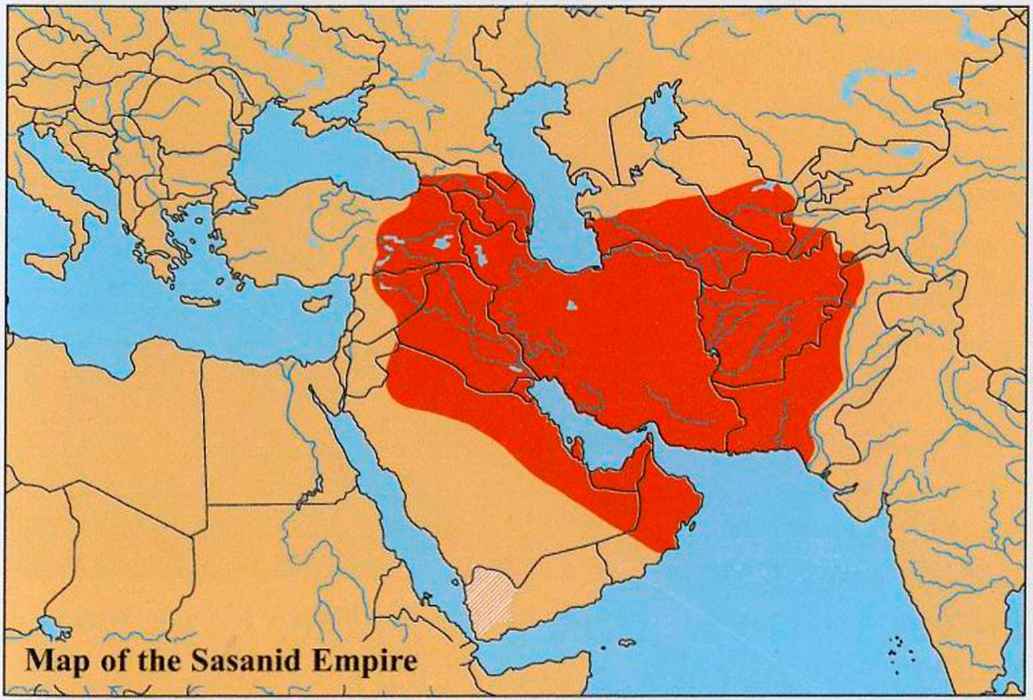
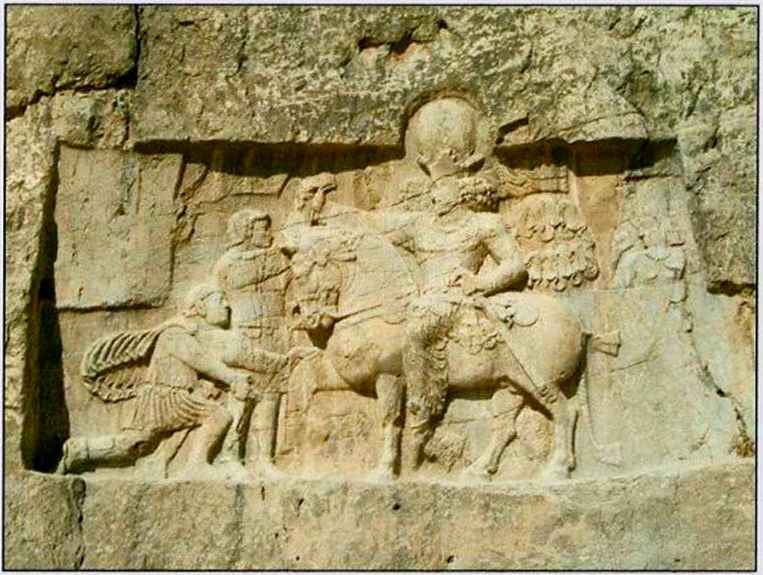
Shapur Rock Relief of Naqsh-e Rustam
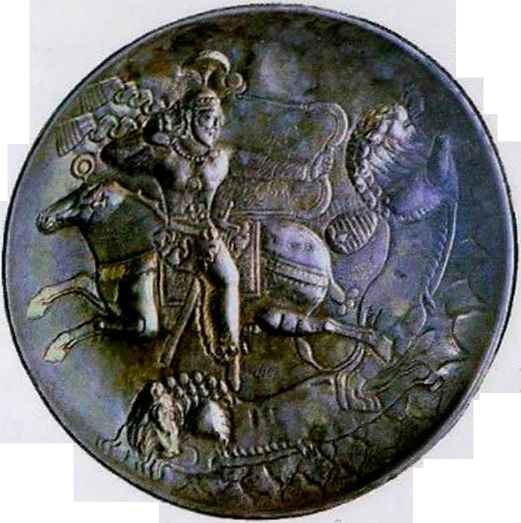
Shapur Rock
616 – Persian forces overrun Egypt and subjugate its people
620 – Khosrow II captures Rhodes and restores the Persian Empire as it existed in 495 BC under Darius the Great
621 – The year of the Islamic Prophet’s flight from Mecca (Hegira) – the starting point of the Islamic calendar; Khosrow II is defeated by Heraclius
627 – Heraclius gains a decisive victory over the Persians in the Battle of Nineveh
628 – Khosrow II is imprisoned and murdered after a mutiny by the military; his son Hormoz IV makes peace with the Byzantine Emperor Heraclius; the True Cross is returned to Jerusalem
632 – Death of Prophet Mohammad; Abu Bakr succeeds him as the first Islamic caliph
633 – Muslim forces attack Persia
634 – The first caliph, Abu Bakr, is succeeded by Omar
636 – Arabs defeat the Sasanids at Qadisia
637 – Arabs take Ctesiphon
642 – Arabs defeat the Sasanids at Nehavand; Persia is formally annexed to the Arab Caliphate
Four various patterns dividing the object into four separate parts (as seen on this Sasanid shield were among the most popular of late-Sasanid motifs.
A Sasanid king thought to be Khosrow II is portrayed in relief at Taq-e Bustan near Kermanshah. He slays a leaping wild boar from a boat. He is accompanied by a large entourage, including a vessel filled with harp-playing musicians.
They were also persecuted, particularly after the Roman Empire, the archenemy of the Sasanid Empire, had become Christian.
Shapur II, the next important ruler after Shapur I, is credited with the longest reign in Iranian history – 70 years. His period was darkened only by perennial wars with Byzantium over the newly Christianized Armenia. Shapur had several unsuccessful successors until Yazdgerd I initiated a relatively peaceful era. Yazdgerd I left the country to his son, Bahram V. Sur-named Gur (Wild Ass), Bahram became the favorite of Persian popular tradition, which exuberantly celebrated his prowess in hunting and love. Bahrain’s descendant, Qobad, was an unusual king in Iranian history in the sense that he actually cared more about the opinions of the common people than of the highly-placed courtiers. He moved away from official religion and greatly welcomed Mazdak and his teaching. His son Khosrow I (Chosroes), an orthodox Zoroastrian, however, destroyed the Mazdakites in a great massacre. Nonetheless, this act has not prevented him from being entitled the Just. Khosrow’s grandson, Khosrow II, was surnamed Parviz (the Victorious). He was immortalized in Persian literature for his devotion to his wife, an Armenian Christian called Shirin. During Khosrow’s rule, the Persian Empire occupied the largest area in its history and was marked by the highest level of civilization. At this time, a message was brought to the king from Medina, bidding him acknowledge Mohammad as the Prophet of God. The king treated the missive with contempt, little thinking that before many years had passed the followers of the Prophet would have swept away the Sasanid line. Instead, he ordered his agent in Yemen called Bazan to capture the Prophet and bring him before the king. However, this mission was never accomplished because of Bazan’s conversion to Islam.
At Khosrow’s death, eleven rulers succeeded one another to the vacant throne, two queens among their number – the first women who had ever held the scepter in Persia – but their united reigns amounted to only five years. After a succession of short-time rulers, Khosrow’s grandson, Yazdgerd III, took the throne. His story is reminiscent of the story of Darius III Achaemenid. Like Darius, Yazdgerd was not destined to rule. A new force was coming from the Arabian deserts, a force that changed both the state and the religion. In 650, only a few years after the death of Prophet Mohammad, the Muslim armies attacked the southern provinces of the Sasanid Empire. Soon afterwards, Ctesiphon, the Sasanid glorious capital and the largest city in the world, was invaded and sacked by the Muslim armies. At the battle of Nehavand, the Arabs utterly defeated the Persians and gained possession of their national standard, the blacksmith Kaveh’s leather apron. Yazdgerd sought refuge in one province after another, until he was assassinated near Merv.
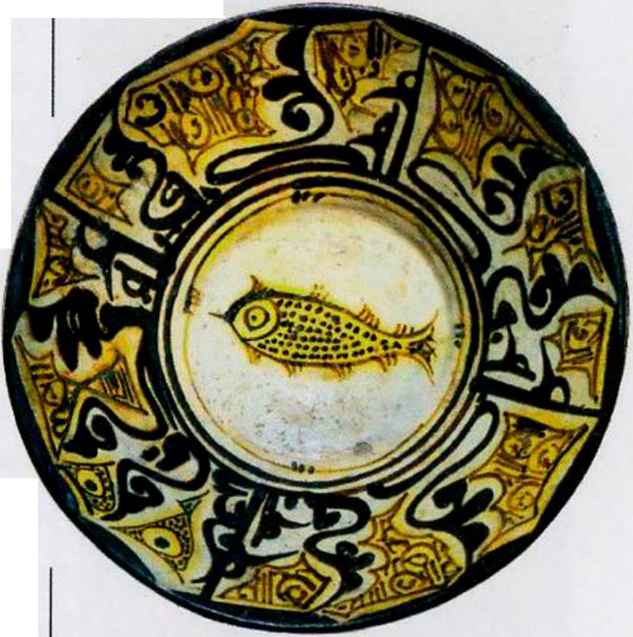
brain-travela
Bowl from the early-Islamic period is today on display in the Ceramics and Pottery Museum in Tehran.
Arab Conquest and the Early Iranian Islamic Dynasties 636-C .1100:
The Muslim Arabs who toppled the Sassanid Empire were inspired by a new religion -Islam.
Although the Koran, the holy book of the new religion, considered people equal regardless their race and social status, the conquerors, especially the Umayyads (the Muslim rulers who succeeded Prophet Mohammad), tended to stress the primacy of Arabs. Despite this, the Iranians rapidly integrated into the new Islamic community. They began to contribute significantly to all branches of Islamic learning and to play an important role in the economic and even political life of the new Muslim Empire. The new caliph came to power due to the Iranian military leader called Abu-Muslim, who led the armies of Saffah against the last of the Umayyad caliphs. Saffah was a great-grandson of Abbas, Prophet Mohammad’s uncle, so he called his dynasty Abbasid. The Abbasid dynasty was the most famous in the Islamic world. Abbasid caliphs were the generous patrons of Islamic culture and arts. However, despite the outstanding progress achieved in the cultural field, the military problems.
642-661 – Rule of the Rightly Guided Caliphs
644 – Caliph Omar is assassinated by Abu Lolo (plS4) in Medina and succeeded by Osman 656 – Caliph Osman is assassinated in Medina and succeeded by Mohammad’s nephew and son-in-law Ali
661 – Imam Ali is assassinated in Kufa
661-750 – Umayyad Caliphate, ruling from Damascus
680 – Imam Hossein, Imam Ali’s son, is killed in Karbala in Iraq; his martyrdom will be commemorated annually by Shiite Muslims 696 – Arabic becomes the official language of the Islamic world 744-749 – Shiite revolt led by Abu Muslim results in establishing the Abbasid Caliphate 750-1258 – Abbasid Caliphate, ruling from Baghdad 771-814 – Rule of Charlemagne, king of the unified Franks and then the first Holy Roman Emperor 817 – 8th Shiite Imam, Reza, dies of suspected poisoning and is buried in Mashhad 820-873 – Rule of the Tahirid dynasty in Khorasan 838 – Persian social and religious revolutionary Babak is executed by the Abbasid caliph al-Mutasem 867-903 – Rule of the Saffarid dynasty in Sistan.
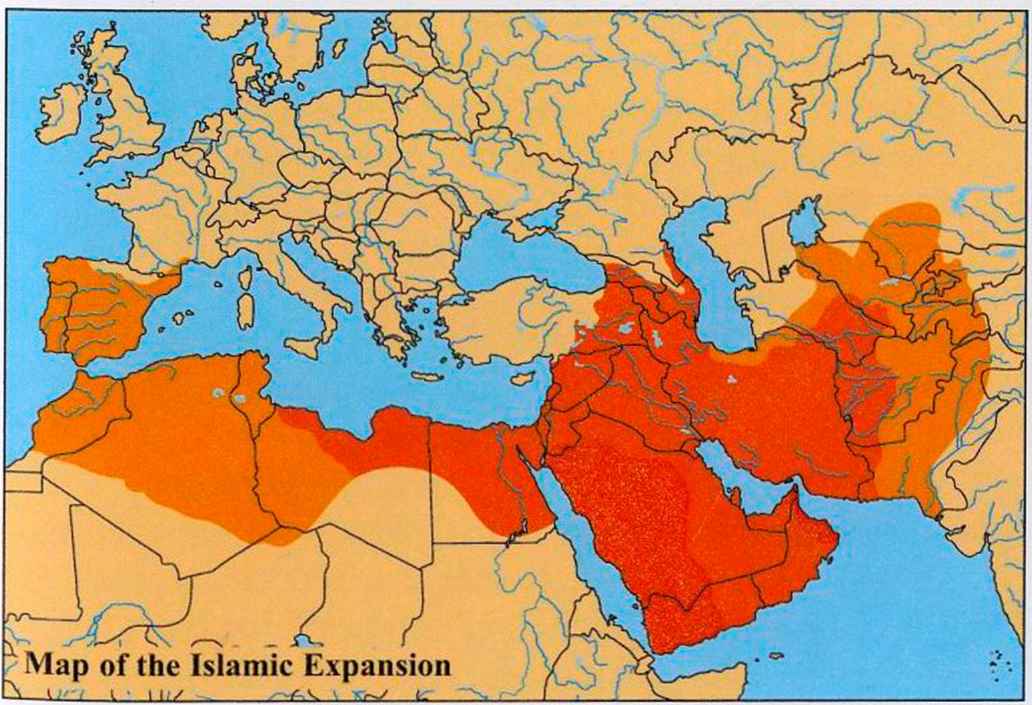
umayyad-empire
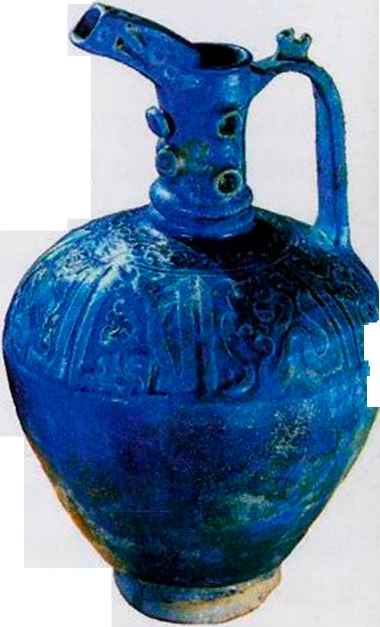
fragment-the-arab-conquests-yarmouk
Ghaznavid Dynasty (962-1186)
The Ghaznavid dynasty was of Turkish origin. It was founded by Saboktekin, a former Turkish slave who was recognized by the Samanids as governor of Ghazna (modem Ghazni, in Afghanistan). As the Samanid dynasty weakened, Saboktekin consolidated his position and expanded his domains as far as the Indian border. His son Mahmud continued the expansionist policy, and during his reign, Ghaznavid power reached its zenith. Mahmud created an empire that stretched from the Oxus to the Indian Ocean. In the west he captured (from the Buyids) the Iranian cities of Rey, Esfahan, and Hamadan. A devout Muslim, Mahmud was the first to carry the banner of Islam into the heart of India. Although the Ghaznavids were proud of their Turkic descent, Mahmud encouraged the use of Persian, and the greatest Persian epic, Shah-Nameh (pp44-46), was completed by Ferdowsi at his court. Among the other great Persians at Mahmud’s court were Biruni, an outstanding scholar of encyclopedic knowledge, and Abolfazl Beyhaqi, the writer of a remarkable history of the Ghaznavids, the first major prose work in New Persian. Mahmud’s son, Masud I, could not keep the integrity of the empire. Challenged by Seljuk Turks, he lost most of his territories, but retained possession of eastern Afghanistan and northern India, where the Ghaznavids continued to rule until 1186.
867-903 – Rule of the Safarid dynasty in Sistan 871-899 – Alfred the Great of England
875-999 – Rule of the Samanid dynasty in Khorasan 922 – First Persian most important Sufi and mystic al-Hallaj is sentenced to death for heresy 928-1077 – Rule of the Ziarid dynasty
936-973 – Otto 1 the Great of Germany
940 – Rudaki, first major poet of the Modern Persian language 945-1055 – Buyid rule; the influence of the Abbasid caliphs is limited to the moral and spiritual spheres as the heads of Orthodox Sunnite Islam
950-1020 – Ferdowsi, poet of the greatest Iranian epic “Shah-Nameh” (pp44-46)
The empire and its administrative organization were left unsolved. Moreover, Iranians who gladly accepted Islam, which freed them from the dictates of the taboo-ridden and excessively ritualized Zoroastrian-ism, could not bear invaders in their homeland. Numerous rebellions took the form of peasant revolts in Azerbaijan and Khorasan. Soon the first Iranian dynasties threatened the Abbasid empire with dreams of Iranian independence. Purely Iranian states were formed in the main part of Iranian territory (Tahirids in Khorasan with Nishapur as the capital, Saffarids in Sistan, Samanids in wealthy Transoxanian and east Khorasanian cities, Ziarids in Tabarestan, and Gorgans and Buyids all over Iran excluding the Samanid properties). The Buyids shared with the Samanids the fame for having brought to fruition the Iranian renaissance.
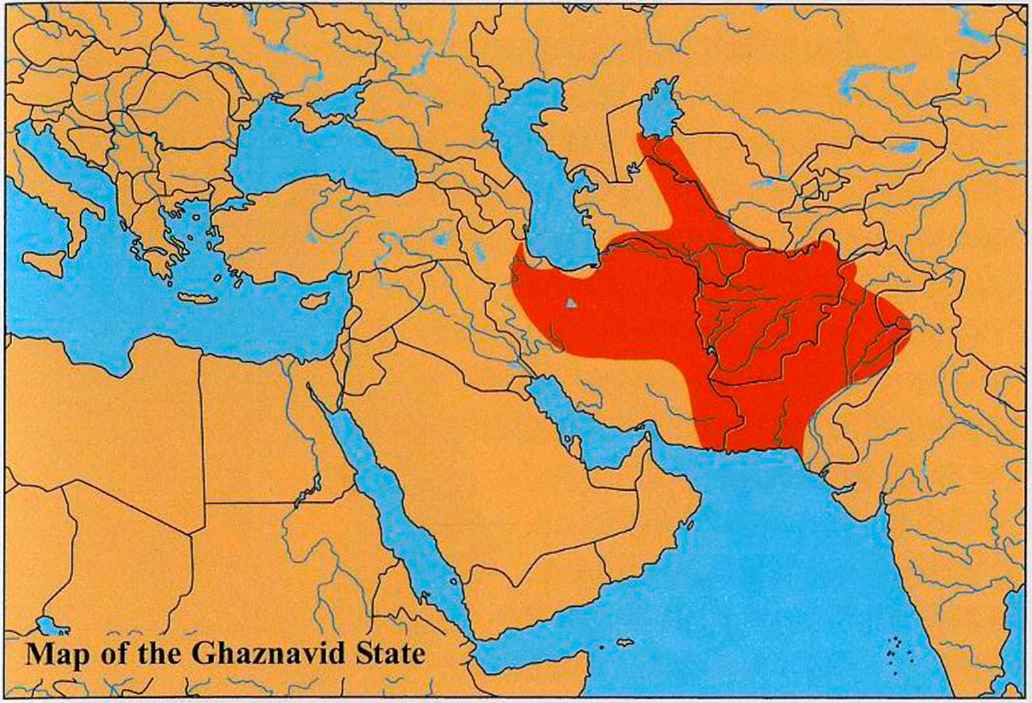
Iran under Seljuk Rulers (1037-1200)
The Seljuks were a clan of the Oghuz Turks, who traced their ancestry to a chieftain named Seljuk. Seljuk’s two grandsons, Chaghri Beik and Toghrol Beik, enlisted Persian support to win realms from the Buyid and Ghaznavid rulers. After “petitioning” the Abbasid caliph for permission, Toghrol Beik was also able to occupy Baghdad. At his death in 1063, Toghrol Beik headed an empire that included Iran and Mesopotamia and held the title King of the East. In 1071, a Seljuk army led by Alp Arslan defeated the Byzantines. The way was open for Turk tribesmen to settle in Asia Minor. Under Alp Arslan and his successor, Malek Shah, the Seljuk Empire included all of Iran, Mesopotamia, Syria, and first influences of Far Eastern Palestine. The Seljuks were art reveal themselves in Seljuk great architectural patrons and ceramics. r , . r in addition to constructing numerous mosques, Madreseh, orphanages, caravanserais, and bridges, they were particularly known for their tomb-towers. Their buildings are notable for their decorative masonry, elaborately ornamented portals, and the use of Kufic script as an architectural decorative device. The Seljuks also attained a high standard in decorative arts, especially in metalwork, wood carving, and pottery.
Important Seljuk Kings:
Toghrol Beik – 1037-1055 Alp Arslan – 1063-1072 Malek Shah – 1073-1092 Sanjar- 1117-1157
The tomb-tower of Gonbad-e Sorkh (Red Dome) in Maragheh in northwestern Iran is a typical example of Seljuk architecture characterized by its distinctive brickwork.
1037 – Seljuk Turks invade Persia under Toghrol Beik 1042 – Seljuk Turks rise against their Byzantine overlords 1055 – Toghrol Beik ends the Buyid rule and makes himself temporal master of the caliph 1048-1123 – Omar Khayyam, a great mathematician, poet and astronomer (p47) 1063-1092 Nezam al-Molk ip57), the renowned prime minister of Alp Arslan and Malek Shah Seljuk is assassinated by the Ismailites
1064 – Seljuk Turks conquer Armenia
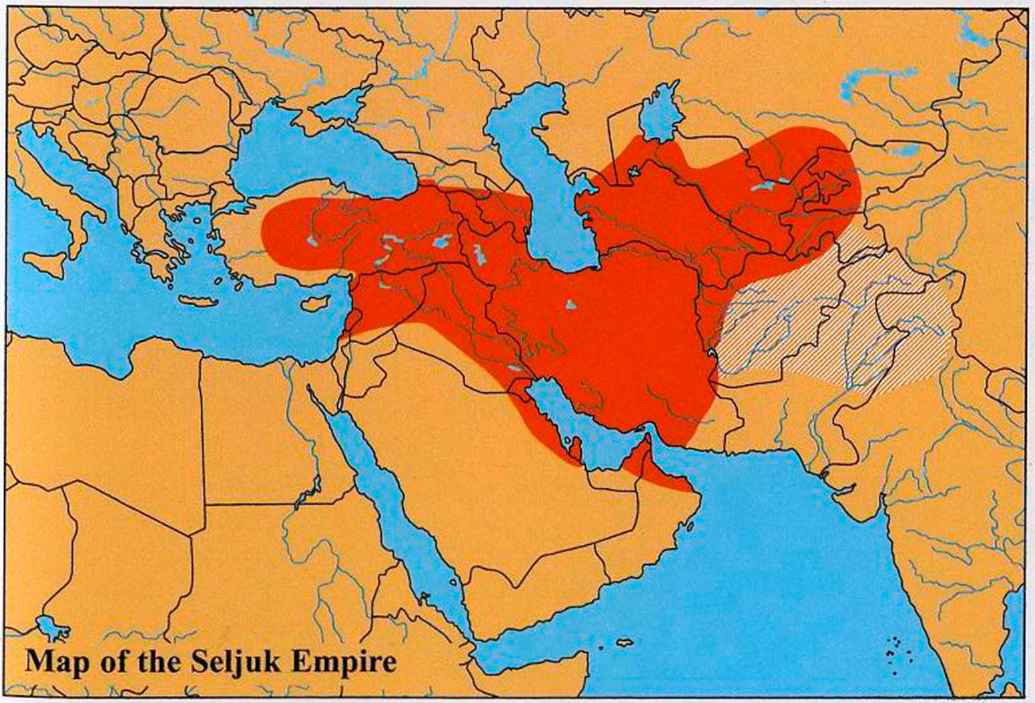
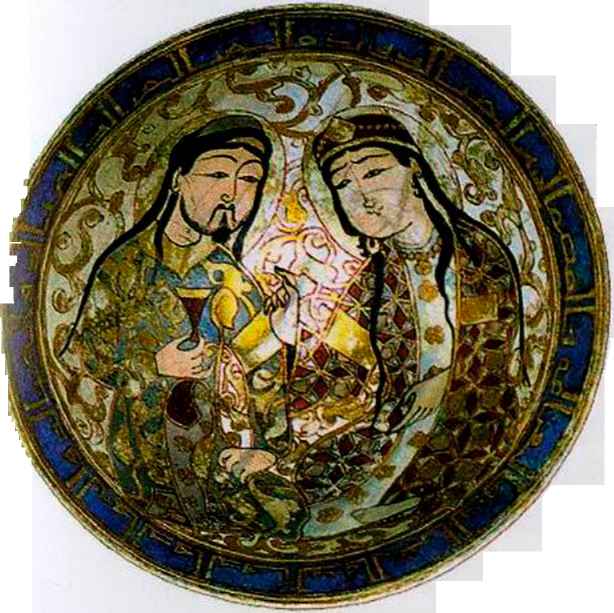
Mongol Rulers of Iran (1219-1353)
Mongol occupation was disastrous to Iran. Numerous cities were razed, and a large number of people (particularly males) were killed. The Kharezm-Shahs could not oppose the Mongol hordes led by Genghis Khan. The last Kharezm-Shahs’s prince, Jalal od-Din, tried to restore the empire but failed to unite the Iranian regions, although by that time Genghis Khan, who had withdrawn to Mongolia, was dead. Iran was left divided between Mongol agents and local adventurers, both of whom profited from the lack of order.
A second Mongol invasion began when Genghis Khan’s grandson Hulagu Khan destroyed the Ismailite fortress at ewer inlaid with Alamut. He then besieged silver and copper dates from the I2th-13th centuries (today in British Museum in London).
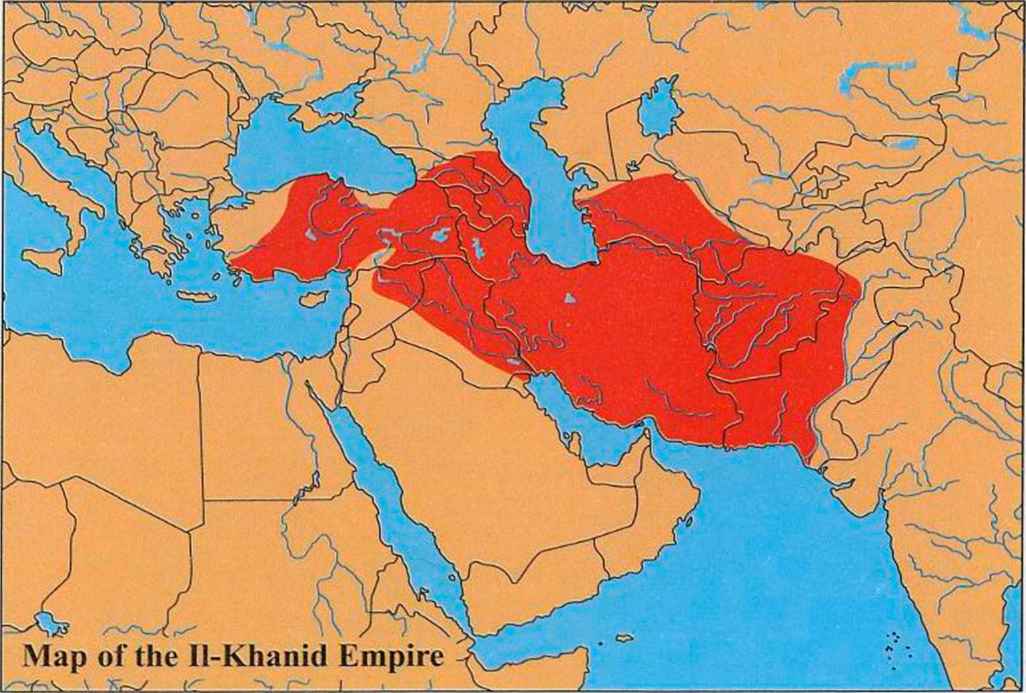
cengizhan-rlar-harita
The Soltaniyeh Dome near Zanjan is one of the most famous memorabilia of Oljeitu, the Il-Khanid ruler who was reportedly buried there.
Ordered the execution of the last Abbasid caliph. Hulagu hoped to consolidate Mongol rule over western Asia and to extend the Mongol Empire as far as the Mediterranean. He made Iran his base, but the Mamluks of Egypt (1250-1517) prevented him and his successors from achieving their imperial goal. Instead, a Mongol dynasty, the Il-Khanids, or “Deputy Khans” to the Great Khan in China, was established in Iran to attempt repair of the damage of the first Mongol invasion. They made Azerbaijan their center and chose Maragheh as the first capital until Sultaniyeh was built early in the 14th century. A later Mongol ruler, Ghazan Khan, and his famous Iranian vizier of Jewish descent, Rashid od-Din Fazlollah, brought Iran a partial revival. Ghazan Khan was the first Mongol ruler to adopt Islam. His successor to the throne was Oljeitu. Oljeitu changed his religious affiliations several times. A great-grandson of Hulagu, founder of the Il-Khanid dynasty, Oljeitu was baptized a Christian and given the name Nicholas by his mother. As a youth, he adhered to shamanism but was later, apparently under the influence of one of his wives, converted to Sunnite Islam, taking the name Mohammad Khodabandeh. During the winter of 1307-08, a bitter religious feud ensued between the adherents of the Hanafi and Shafii schools of Sunnite Islamic law. This so disgusted Oljeitu that he considered converting back to shamanism, but that course proved politically impossible. Greatly influenced by the Shiite theologian, Ibn al-Mutahhar al-Hilli, he came to embrace the Shiite religion. On his return from a visit to the tomb of Imam Ali in Iraq, he proclaimed Shiite Islam to be the state religion. Oljeitu’s conversion gave rise to great unrest, and civil war was imminent when he died in 1316. His son and successor, Abu Said, reconverted to Sunnite Islam and averted war, but during his reign factional disputes and internal disturbances became rampant. The Il-Khanid line was interrupted by the death of Abu Said, who died without leaving an heir, and Iran again lapsed into petty dynasties – the Jalayirids, Injuids, and Mozaffarids.
The Sultaniyeh Dome near Zanjan is one of the most famous memorabilia of Oljeitu, the Il-Khanid ruler who was reportedly buried there.
1380-1393 – Tamerlane conquers Iran
1405 – Tamerlane’s death; the accession of his son Shahrokh 1411-1492 – Jami, the last important Persian classical poet
1429 – Joan of Arc (Jeanne d’Arc) bccomes the heroine of France
1447-1452 -Rule of Ulugh Beik, Timur’s grandson, who is better remembered in history as a great scientist 1452-1466 – Abu Said’s rule
1453 – Constantinople falls to the Ottoman Turks, who end the Byzantine Empire that has ruled since the fall of the Roman Empire in 476 1455-1536 – Behzad, one of the major Persian painters and the founder of the Herat miniature school 1478-1506 – Rule of decorations of the Shrine of Ali ibn Hossein Bayqara
J afar in Qom) reached the highest 1500 – Overthrow of the level of craftsmanship during the Timurids Mongol and Timurid periods.

tamerlane-mongol
Timurid and Turkman Rulers (1389-1508)
Tamerlane (Timur), who claimed descent from Genghis Khan’s family, was the next ruler to achieve the status of emperor.


mosque-dark-blue-tabriz
The splendid Blue Mosque in Tabriz, founded in 1465 at the order of Jan Beygom Khatun, a pious Jahanshah Qara-Qoyunlu s consort, is the most famous architectural commission from the Turkman reign.
VsA.
Iran during the Timurid period
1406-1469 – Qara-Qoyunlu dynasty
1439-1467 – Rule of Jahan Shah, the most prominent Qara-Quyunlu ruler, famous for his patronage of architecture and the arts of the book
1453-1490 – Uzun Hasan Aq-Quyunlu
1456 – The Gutenberg Bible published at Mainz
1460-1485 – England’s Wars of the Roses
1462-1505 – Ivan 111 the Great, the first Russian national sovereign 1469-1508 – Aq-Quyunlu dynasty 1492 – Christopher Columbus crosses the Atlantic 1497 – Rostam Shah dies, leaving the Aq-Quyunlu tribe without a powerful ruler
1500 – Aq-Quyunlu dynasty comes under attack from tribesmen commanded by the Safavid leader Ismail, at that time only 14
The splendid Blue Mosque in Tabriz, founded in 1465 at the order of Jan Beygom Khatun, a pious Jahanshah Qara-Quyunlu s consort, is the most famous architectural commission from the Turkman reign.
1509-1547 -Henry VIII of England
1510 – Shah Ismail defeats an Uzbek army extending his realm from the Tigris to the Oxus 1514-1555 – War with Turkey
1514 – Shah Ismail is defeated at Chaldoran by his Sunnite rival, the Ottoman Sultan Selim I
1515 – Portuguese naval strategist Alfonso de Albuquerque takes Hormuz at the mouth of the Persian Gulf
1517 – Reformation of the Catholic Church, appearance of Protestanism (gets its name in 1529)
1520-1566 – Soleiman the Magnificent of Turkey the huge forces of earlier Mongol leaders, so his conquests were slower than those of Genghis Khan or Hulagu Khan. Ironically, this ruthless warrior and appalling killer was a great patron of arts and initiated a true civilization with a center in Samarqand. Timur was famed for his great interest in unorthodox religious beliefs, among them Sufism (p36-37), which developed considerably in his time.
Under Timur’s son Shahrokh and grandson Ulugh Beik the Iranian culture began to flourish. Their capital, Herat, was turned into the seat of splendid culture, the atelier of great miniature painters, and the home for a revival of Persian sciences and arts. The Timurid Empire, however, disintegrated rapidly after Ulugh Beik’s death. After the Timurid princes, Iran was dominated, particularly in its northern part, by the Qara-Qoyunlu, the “Black Sheep” Turkmen tribe. On Shahrokh’s death, their leader, Jahan Shah, extended his rule deep into Iran. Their rival was another Turkman tribe of Aq-Qoyunlu, the “White Sheep”, who were concentrated around Diyarbakir in Turkey. The White Sheep, led by Uzun Hasan, destroyed Jahan Shah’s troops by the end of 1467. Uzun Hasan established a short-lived empire but was confronted by a new power in Asia Minor -the Ottoman Turks. Minor Mongol tribes, Uzbeks, and Turkmen clans ruled over Iran until the rise of the Safavid dynasty.
Safavid Dynasty (1501-1736)
While the Turkman dynasties ruled in Azerbaijan, Sheikh Heydar headed a movement that had begun in the late 13th century as a Sufi order under his ancestor, Sheikh Safi od-Din of Ardabil, who claimed descent from the Seventh Shiite Imam, Musa al-Kazem. By the end of the 15th century, this Sufi order was turned into a militant movement with numerous followers, mainly from the Turkman tribesmen of Anatolia. They were called the Qizil-Bash, Red Heads, because of the distinctive red headgear that they had adopted to mark their adherence to the Safavids. With their help, the Safavids conducted several successful military campaigns, especially in the Caucasus. By virtue of their descent from the Prophet’s family, the Safavid movement was invested with a semi-sacred character, and the religious character of the new claimants to the throne was particularly acceptable to the Persians. When Sheikh Heydar was killed in one of his battles in the Caucasus, his son Ismail avenged his death by con-quering Azerbaijan and then the whole of Iran. In 1501, Ismail was proclaimed Shah of Iran. He became the founder of one of the most famous ruling dynasties in Iranian history – the Safavids.
The Safavids declared Shiite Islam the state religion and used proselytizing and force to convert the large majority of Muslims in Iran to the Shiite sect. Their main external enemies were the Uzbeks and the Ottomans. The Uzbeks were an unstable element along Iran’s northeastern frontier, raiding Khorasan and blocking the Safavid advance northward into Transoxiana. The Ottomans, who were Sunnites, were rivals for the religious allegiance of Muslims in eastern Anatolia and Iraq and pressed territorial claims in both these areas and in the Caucasus. A series of battles between Iran and the Ottoman Turkey lasted throughout the reign of the Safavids.
Tahmasb, the eldest son and successor of Shah Ismail, had none of his father’s appeal or personal courage. For a long period after coming to the throne, he was a pawn of powerful tribal leaders.
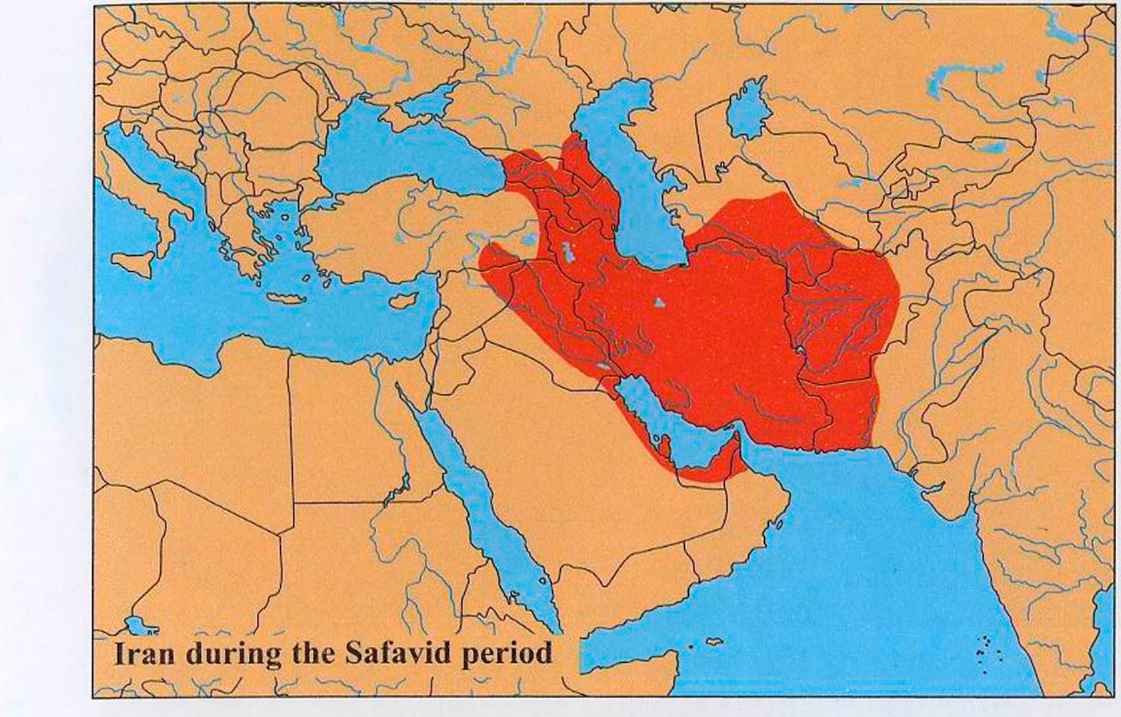
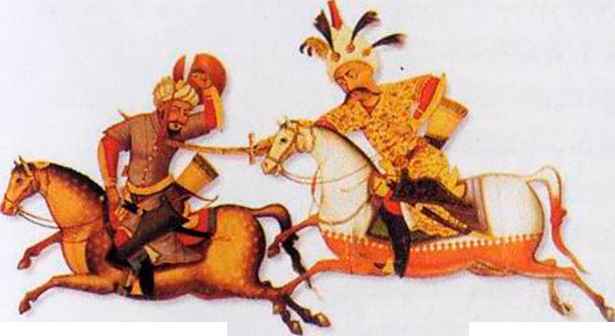
ismail-safavid-leader
Ismail I (1501-1524)
Abbas I, The Great (1587-1629)
1533-1584 – Ivan IV the Terrible of Russia, who in 1547 is crowned czar (caesar) to be the first Russian ruler formally to assume this title 1534 – Ottoman forces attempt to take Tabriz from the Persians; Shah Tahmasb, now 20, has his regent executed and assumes personal power
1548 – Ottoman forces occupy Tabriz
1555 – Safavid capital is removed to Qazvin
1558-1643 – Queen Elizabeth of England
1582 – A new Gregorian calendar is instituted by Pope Gregory 1589-1610 – Henry IV the Great of France
1590 -Shah Abbas and the Ottoman Sultan Murad III end a 12-year war
1595 – The Dutch East India Company sends its first ships to Iran
1587 – Shah Abbas chooses Esfahan as his capital and undertakes to make it a showplace of the world.
1603-1625 – James I of England, the first king to rule over a united kingdom
1616 – England’s East India Company begins trading with Persia from its Indian base at Surat 1618 – The Ottoman Sultan Mustapha I gives up Georgia and Azerbaijan by treaty with Abbas the Great
1622 – Persians take Qandahar from the Mughal Empire and drive the Portuguese out of Hormuz.
1623 – Abbas I takes all of Mesopotamia from the Ottoman Turks
1629 – Abbas I dies on January 19 at age 72 after a 42-year reign. Two of his five sons died, he had two others executed and another blinded, so he is succeeded by a grandson aged 13. The new shah has his grandfather’s counselors beheaded along with most of Persia’s best generals, all the blood princes, and even some of the princesses. Qandahar’s Persian governor defects to the Uzbeks, who take the city and province.
1630 – The Ottoman Sultan Murad IV defeats the Iranian army and captures Hamadan.
1635 – Murad IV leads an Ottoman army against Persia, Erivan capitulates after a siege, Tabriz surrenders without resistance but is deliberately destroyed
1636 – Shah Safi retakes Erivan and signs a treaty with Constantinople setting western borders that will remain substantially unchanged for more than two centuries
1638 – Murad IV retakes Baghdad from the Persians after a 40-day siege, slaughtering the city’s defenders
1642-1646 The Great Civil War in England.
1643-1715 – Louis XIV of France 1649-1660 – The Commonwealth is established in England 1650 – Abbas II retakes Qandahar, but Mughal emperors will besiege the city repeatedly 1667 – Shah Abbas II dies at age 33 after a 25-year reign. His ministers pretend that his son of 20 is blind and try to install a younger son, but a court eunuch betrays their scheme, and the dissolute elder son will reign as Soleiman I 1689-1730 – Peter the Great of Russia
1707 – The Kingdom of Great Britain is established
1722 – Mahmud, an Afghan chieftain and a vassal of the Safavids, attacks Persia and captures Esfahan, thus ending the Safavid rule decline of the dynasty. He was crowned at a very early age and thus successfully escaped the seclusion of the harem, which may well be the reason why he developed more favorably than the other of Shah Abbas’s successors. Although inclined to lose control under the influence of alcohol and narcotics, he was more gifted than any other descendant of Shah Abbas the Great, and history records him as a just ruler and an intelligent patron of arts. Abbas IT died in 1666 at the age of thirty-three. Abbas’s eighteen-year-old son ascended the throne as Shah Safi. However, shortly after his accession, the shah fell ill. The doctors ascribed his illness to the miscasting of his horoscope at the time of his accession. Therefore on a day proclaimed by the astrologers as unlucky, a mock coronation of a Zoroastrian was performed. The following day, allegedly a lucky one, an effigy of the Zoroastrian was decapitated, and Shah Safi reassumed his throne as Shah Soleiman. Soleiman’s harem upbringing had left him under the thumb of the eunuchs. Like most of the Safavid rulers, he cared more about women and wine than his country. Chardin reported that he could drink any Swiss or German under the table. The Soleiman’s reign was for the most part peaceful, though it was not the ruler’s merit but rather a fortunate culmination of circumstances. His piety earned him the nicknames of “Mullah Hossein” and “Yashki dir” (Turkish: “It is good”), the second deriving from his invariable reply of assent to every proposal made by the clergy. His feebleness accelerated the decline of the country. Once again the eastern frontiers began to be breached, and a small body of Afghan tribesmen led by Mahmud, a former Safavid vassal in Afghanistan, won a series of easy victories before taking the capital. Although the Safavid dynasty claimed rule for many following years, bearing illustrious but hollow names like Tahmasb II and Abbas III, the glory of the Safavid reign was never re-established.
1729-1747 – Nader Shah 1729 – Nader expels the Afghans from Iran.
1736 – Nader ascends the throne 1740-1786 – Frederick the Great, Prussia’s King.

Afsharid and Zand Dynasties:
After a disastrous but brief Afghan occupation, the country was united under the power of Tahmasb Qoli, a chief of the Afshar tribe. He expelled the Afghans in the name of surviving Safavid members, but soon dethroned them and was him- self crowned as Nader Shah. He chose Mashhad as his capital.
He wanted to restore the glory and prestige of his country by regaining the diamond. The treasures brought by Nader I to Iran (today in the Jewelry drove the Ottomans from Georgia Museum in Tehran).
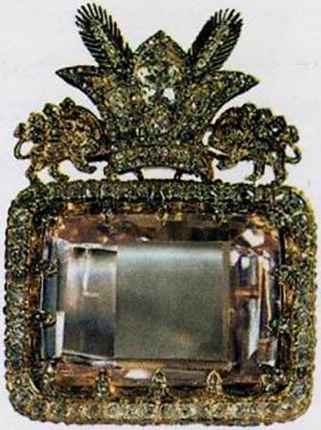
iranian-throne
Karim Khan the king of Zandieh and Armenia and the Russians from the Iranian coast on the Caspian Sea, and restored Iranian sovereignty over Afghanistan. He also took his army on several campaigns into India, bringing back fabulous treasures. Among them were two of the world’s largest diamonds.
Zand decorates the interior of of Light (now part of the the Pars Museum in Shiraz. British Crown Jewels) and the Sea of Light (now in the Jewelry Museum in Tehran). His Indian expedition solved the problem of how to make his empire financially viable. Too powerful and ambitious in the view of some of its neighbors, Nader Shah seemed to have pose a threat to their imperialistic plans. Perhaps a victim to their conspiracy, Nader died from the hands of his own tribesmen, assisted by some Qajar chiefs.
Almost immediately after Nader’s murder, the country fell into anarchy. Afshar, Qajar, Afghan, and Zand chieftains struggled for supremacy, until finally Karim Khan Zand defeated his rivals and unified the country (except for Khorasan) under a loose form of central control. Karim Khan’s geniality and common sense inaugurated a period of peace and popular contentment. He refused to assume the title of shah and ruled as Vakil al-Roaya (Deputy of the Subjects). Shiraz was made the capital city under his rule.
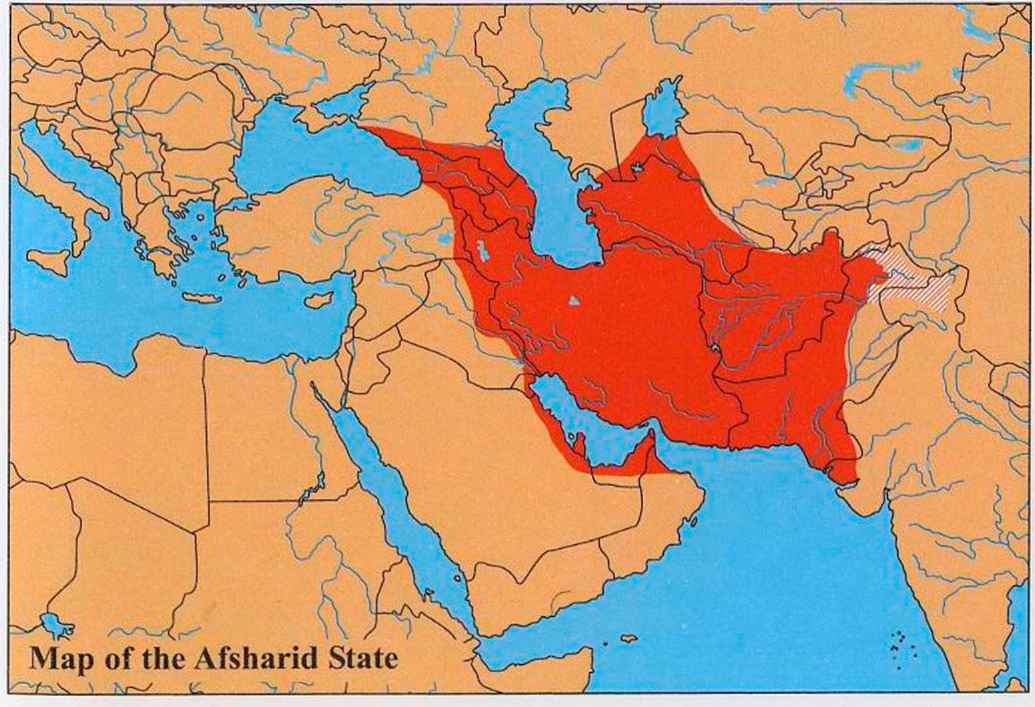
iran-afsharid-map
Qajar Dynasty (1794-1925)
After Karim Khan’s death, Agha Mohammad Qajar, who was brought up at the Zand court, gathered a large force of his Qajar tribesmen and embarked upon a war of conquest. He defeated the last Zand ruler and in the same year took Mashhad, which was at the time the residence of the last Afsharid king. In this way, he made himself master of the country and founder of the Qajar dynasty. Under his successors – Path Ali Shah, Mohammad Shah, and Naser od-Din Shah – a degree of order and stability returned to the country. However, from the early 19th century, the Qajars began to face pressure from two great world powers, Russia and Britain.
1750-1779 – Karim Khan Zand 1756-1763 – Seven Years’ Anglo-French War in North America 1757 – Karim Khan places on the throne the infant Shah Ismail III, the grandson of the last official Safavid king, as a figurehead ruler 1762-1796 – Catherine the Great, Empress of Russia 1775-1783 – The American War of Independence
1776 – The American Declaration of Independence
1789-1894 – Lotf Ali Khan Zand
1789 – Bastille falls, French
Revolution begins
1794 – Lotf Ali Khan is defeated by Agha Mohammad Qajar; Agha
Mohammad Khan chooses Tehran as his capital city.
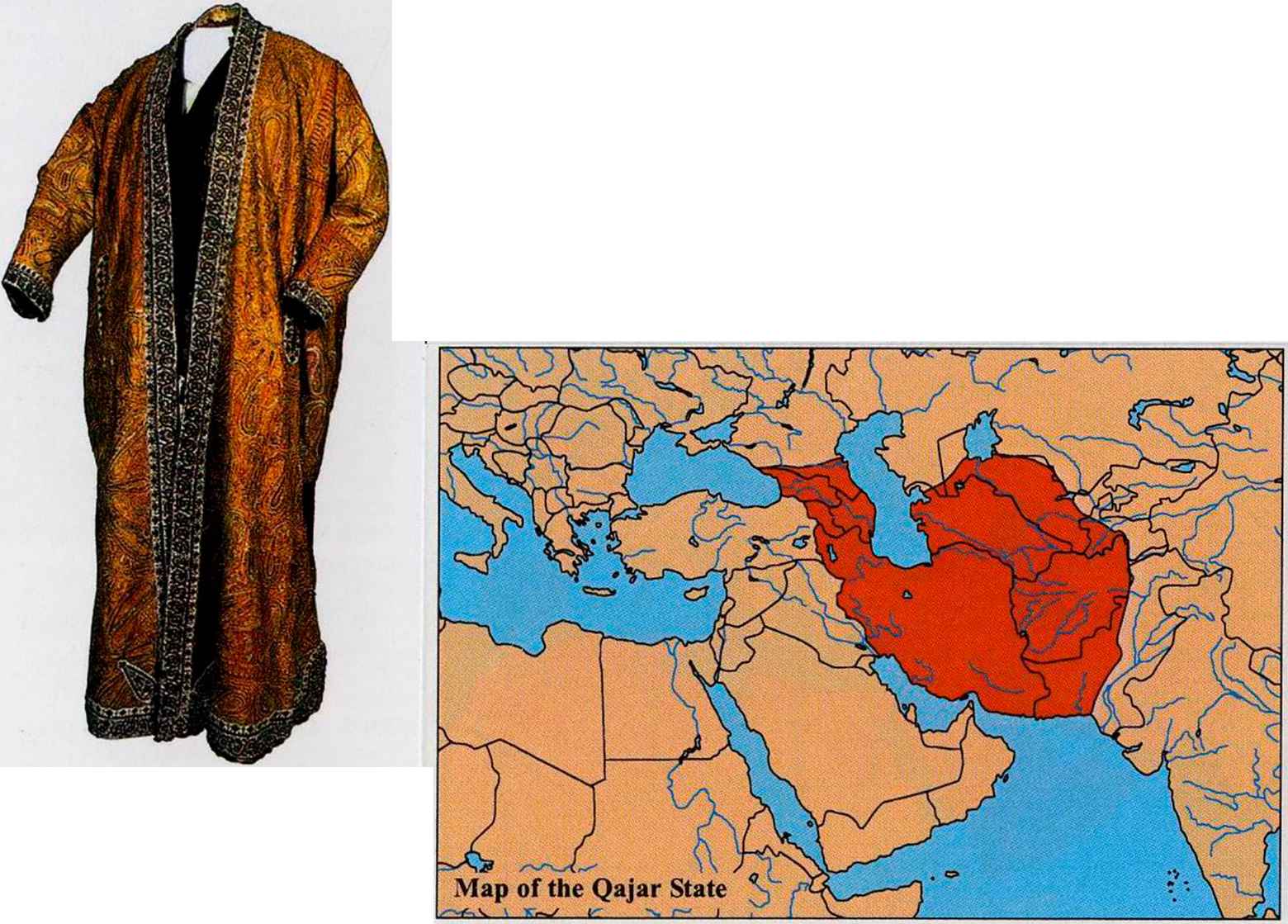
agha-mohammad-khan-qajar-crown
Qajar Kings:
Agha Mohammad Khan – 1794-1797
Fath Ali Shah – 1797-1834 Mohammad Shah – 1834-1848 Naser od-Din Shah – 1848-1896 Mozaffar od-Din Shah – 1896-1907 Mohammad Ali Shah – 1907-1909 Ahmad Shah – 1909-1923
1796 – Agha Mohammad is formally crowned shah 1803-1815 – Napoleonic Wars 1813 – Treaty of Golestan that stipulates Russia’s annexation of former Iranian territories in Georgia and north of the Caucasus region 1819-1901 – Queen Victoria of Britain
1828 – By the Treaty of Turkmanchai Iran acknowledges Russian sovereignty over the entire area north of the Aras River (territory comprising present-day Armenia and Republic of Azerbaijan)
1844-1850 – Preaching of Bab, the prophet of Bahaism 1851 – Amir Kabir, a prime minister of the Qajars, is assassinated (pl66)
1861-1865 – The American Civil War
1905 – Constitutional Revolution; First Revolution in Russia
1906 – Mozaffar od-Din Shah signs the first Iranian constitution 1914-1918-World War I
1917 – February and October Revolutions in Russia
1921 – Coup d’etat of Reza Khan
1925 – Reza Khan is crowned the first Pahlavi Shah
1934 – Hitler becomes Fuehrer of Germany
1935 – Country’s name is changed from Persia to Iran 1939-1945 – World War II
1941 – Britain and the USSR invade Iran and send Reza Shah into exile
1941 – Mohammad Reza Shah ascends the throne
1943 – Tehran Conference of Rosevelt, Churchill, and Stalin
1944 – Reza Shah dies in exile 1951 – Dr. Mohammad Mosaddeq becomes Prime Minister; Nationalization of oil from British control 1953 – British Intelligence and the CIA sponsor a coup d’etat to topple Dr. Mossadeq’s government 1962-1963 – Beginning of the reform programs known as the White Revolution.
1971 – Shah holds in Persepolis an extravagant celebration of 2,500 years of Persian monarchy 1976 – Shah replaces the Islamic calendar with an “imperial” calendar, which began wit i the foundation of the Persian empire more than 25 centuries earlier 1979 – General uprising of the discontent.
In 1909, his son Ahmad, a boy of 11, was crowned. Meanwhile, Reza Khan staged a coup d’etat and took control of all the military forces. After the deposition of the last Qajar Shah, Reza Khan took the throne for himself and started to reign as Reza Shah Pahlavi, having found the last royal dynasty in Iran.
January 16, 1979 – Shah left Iran.
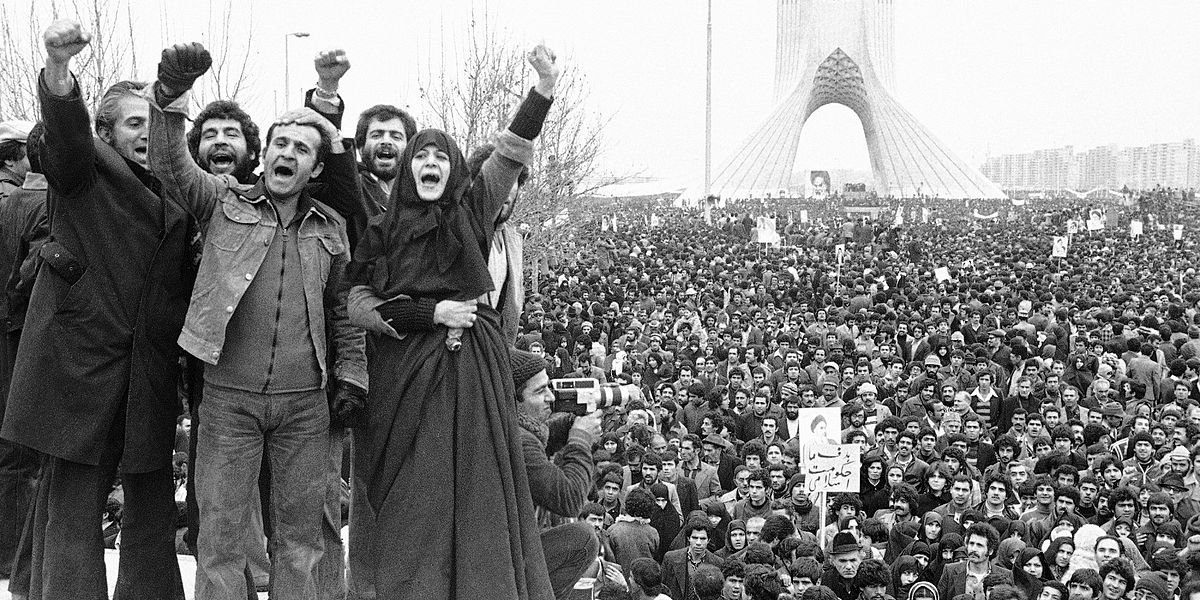
Iranian_Revolution_in_Shahyad_Square
